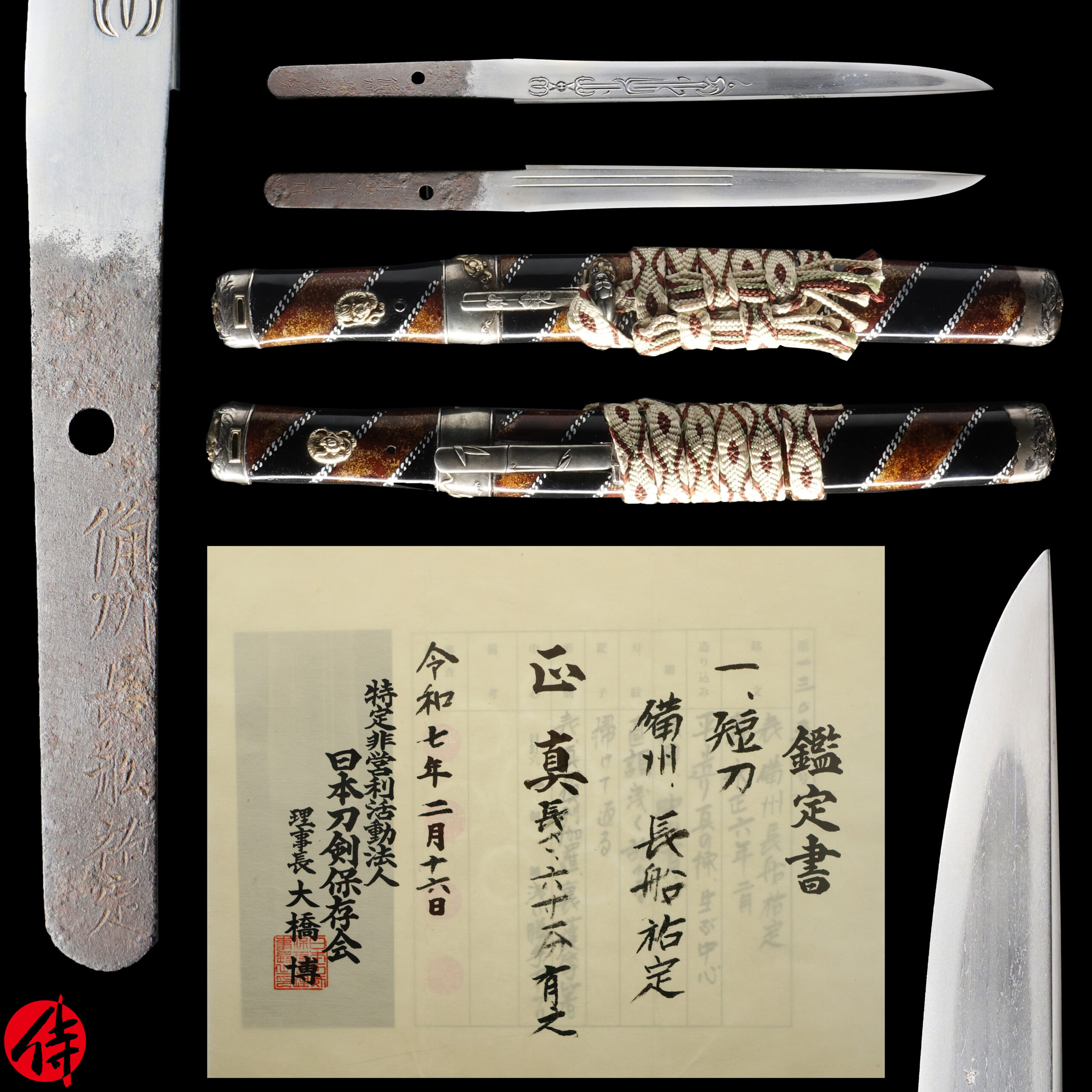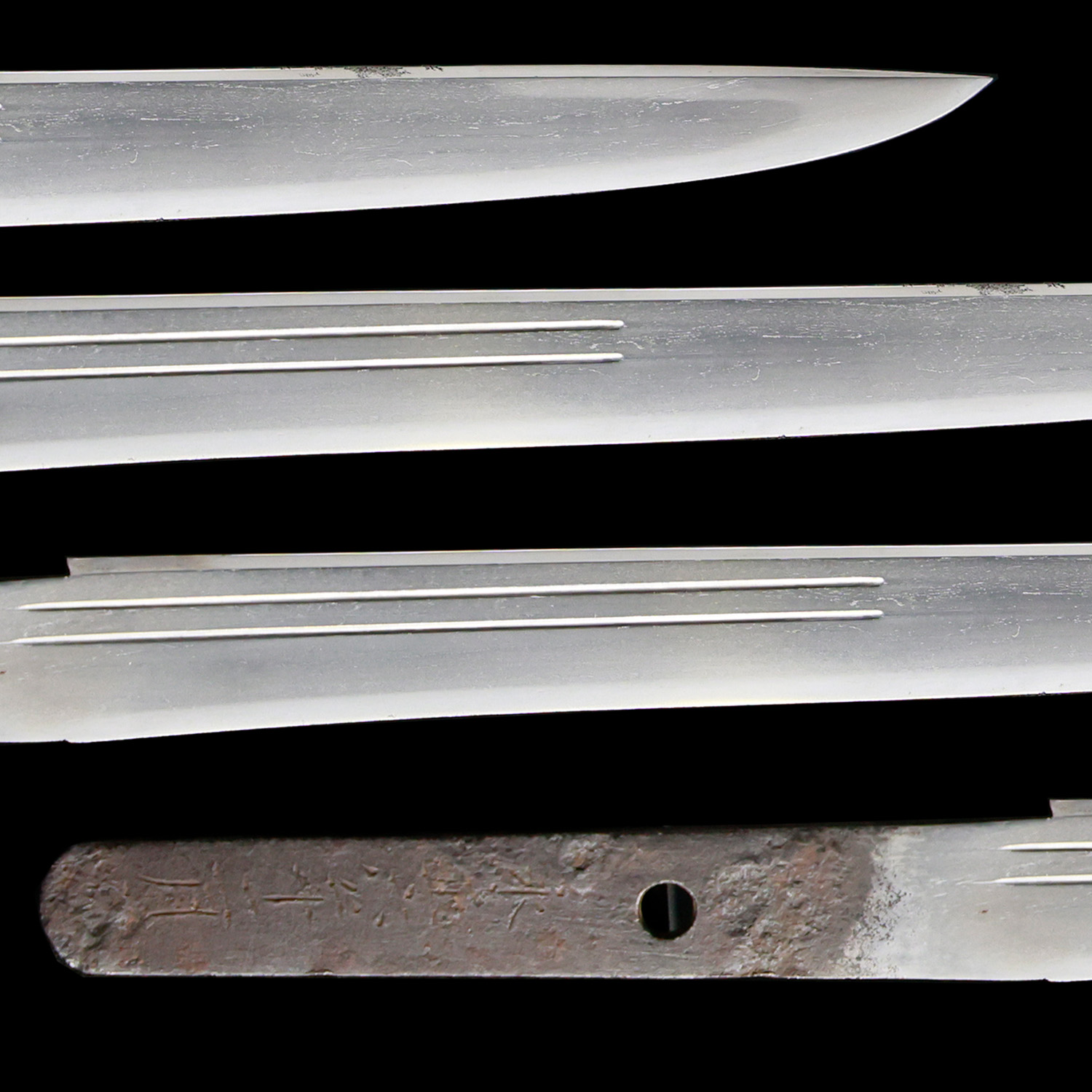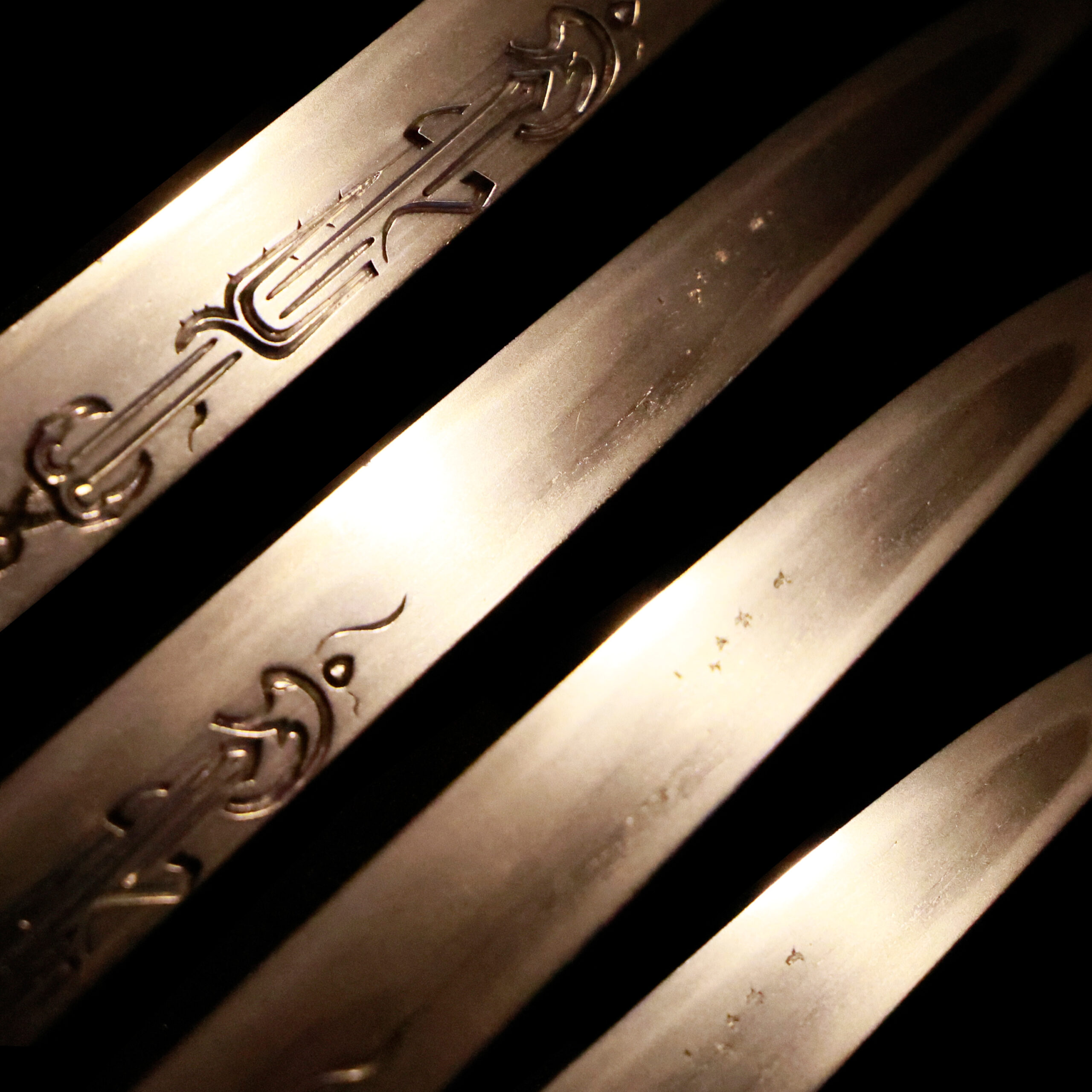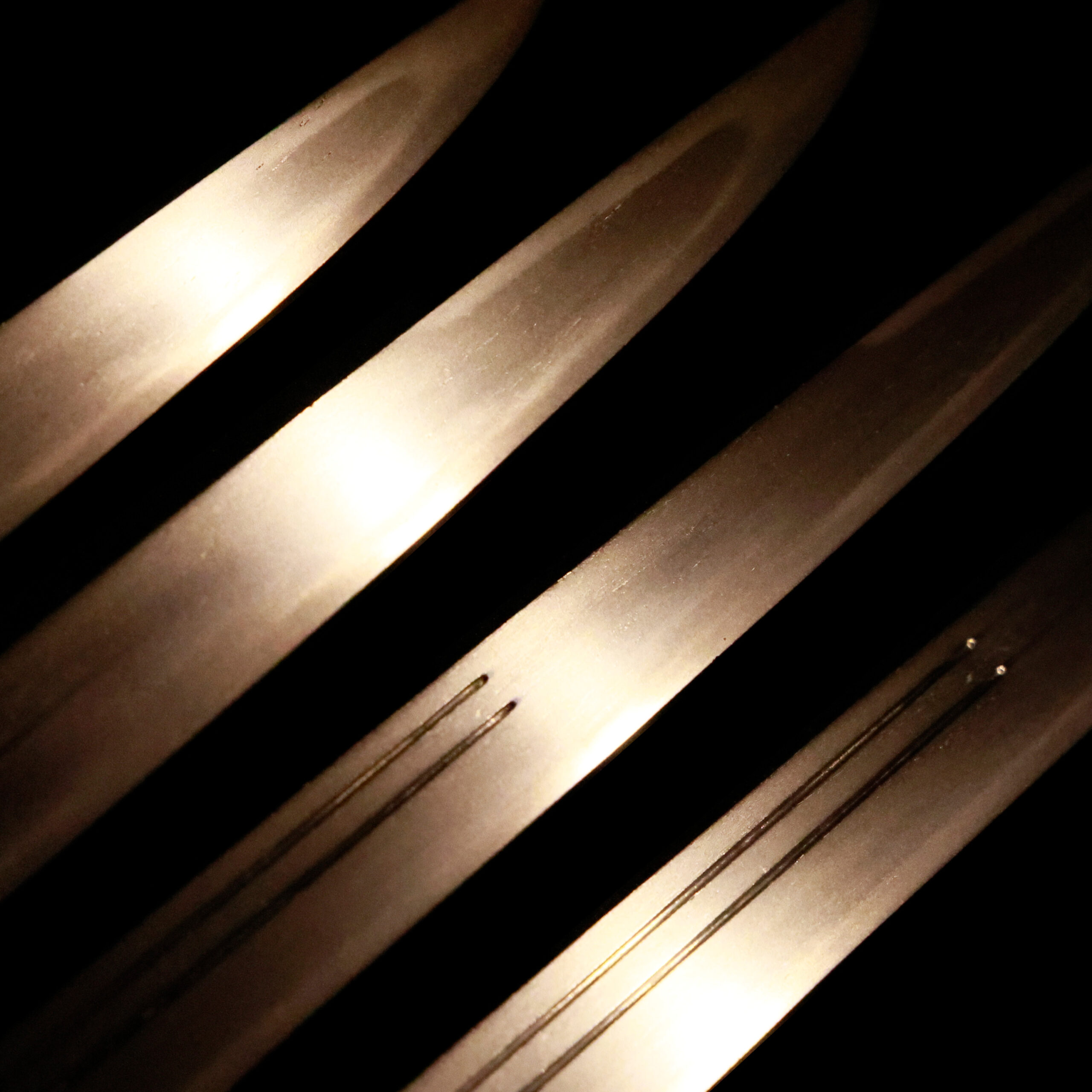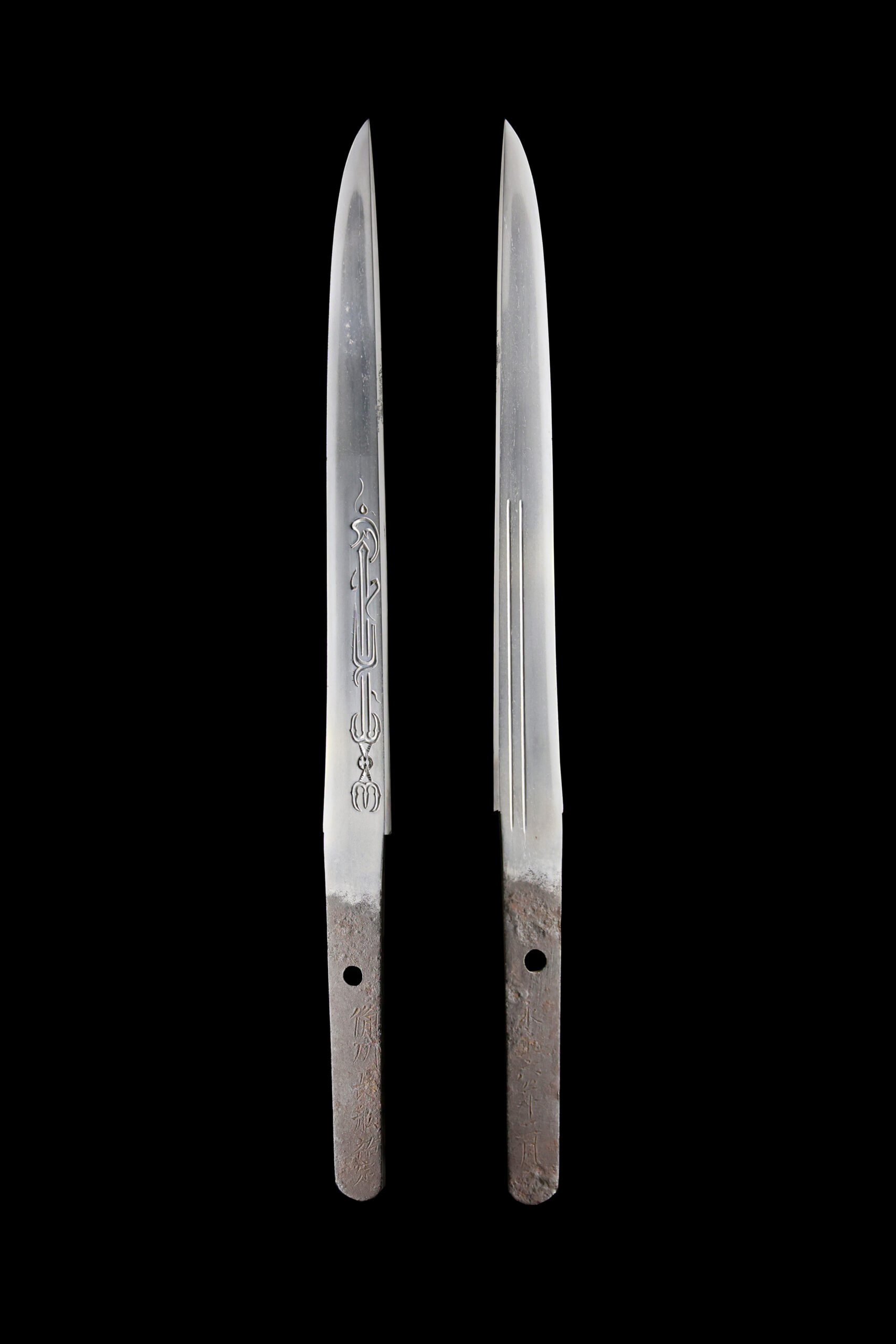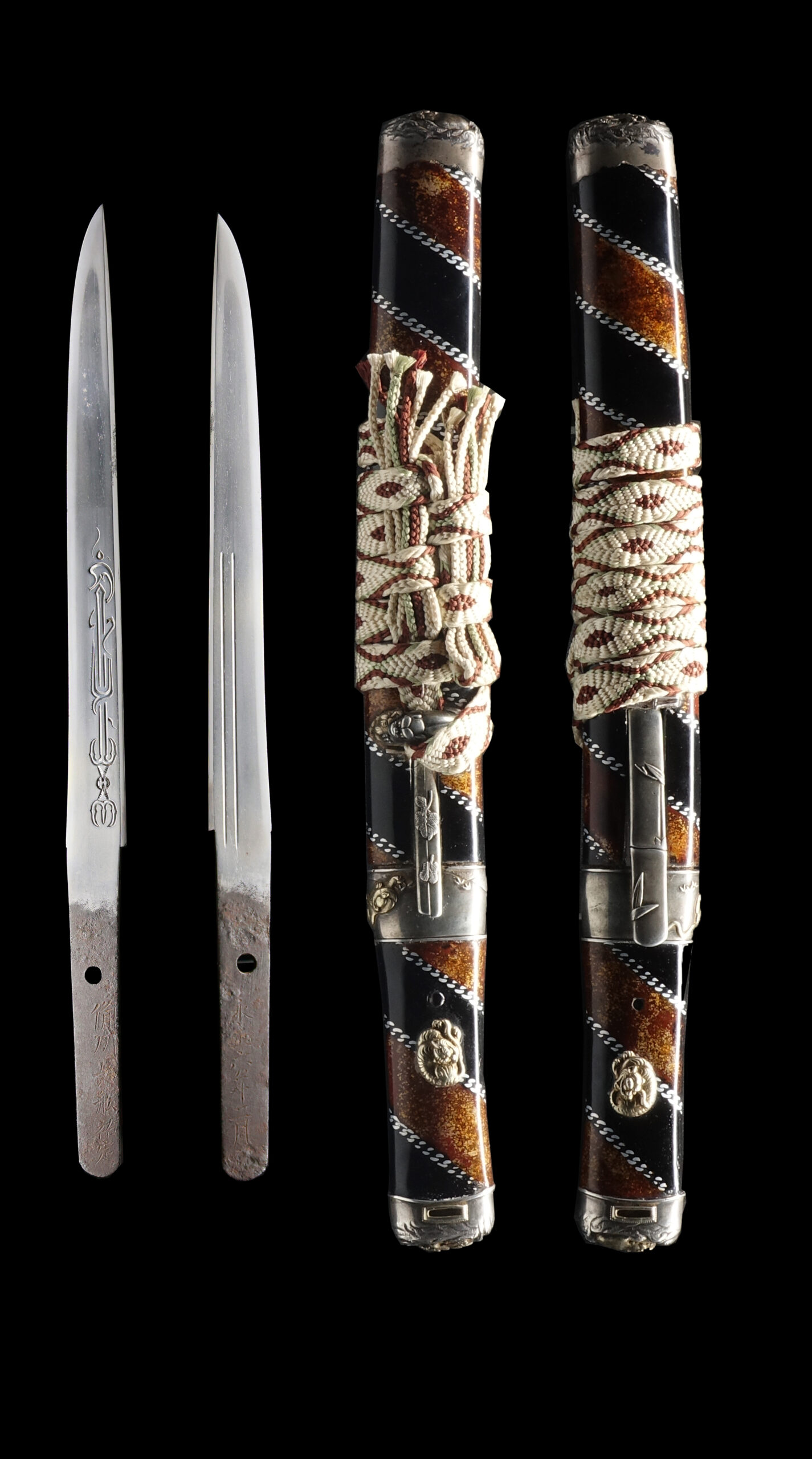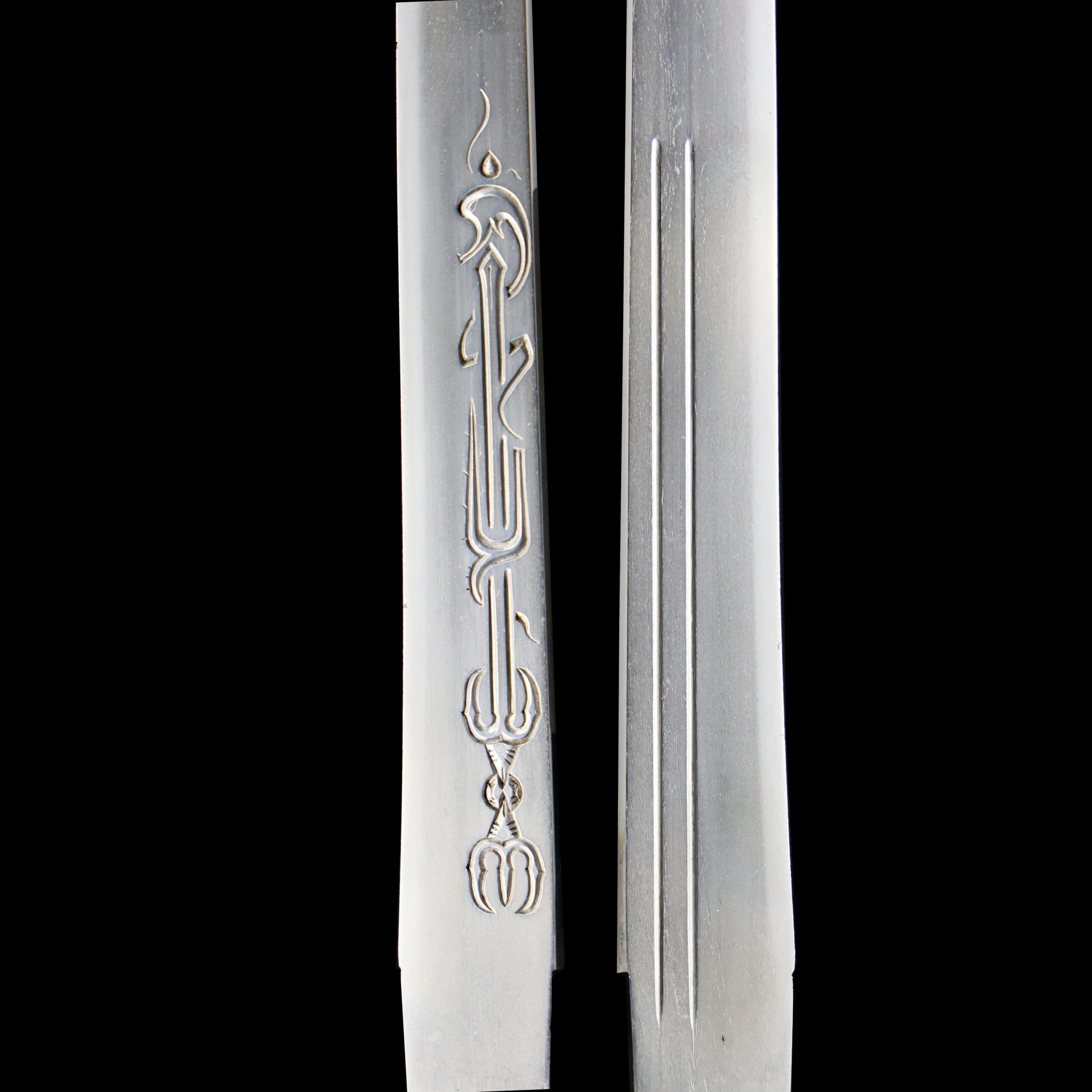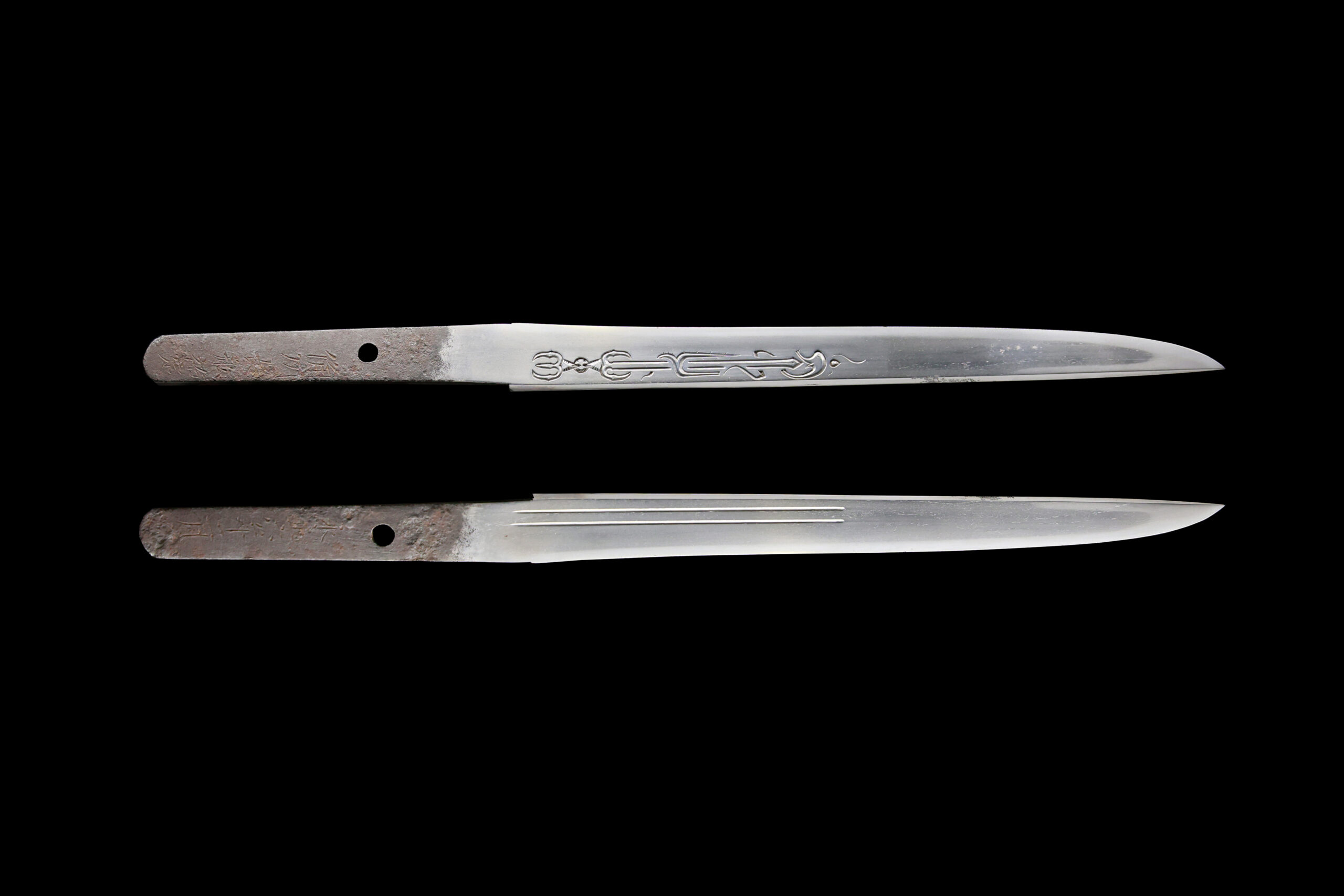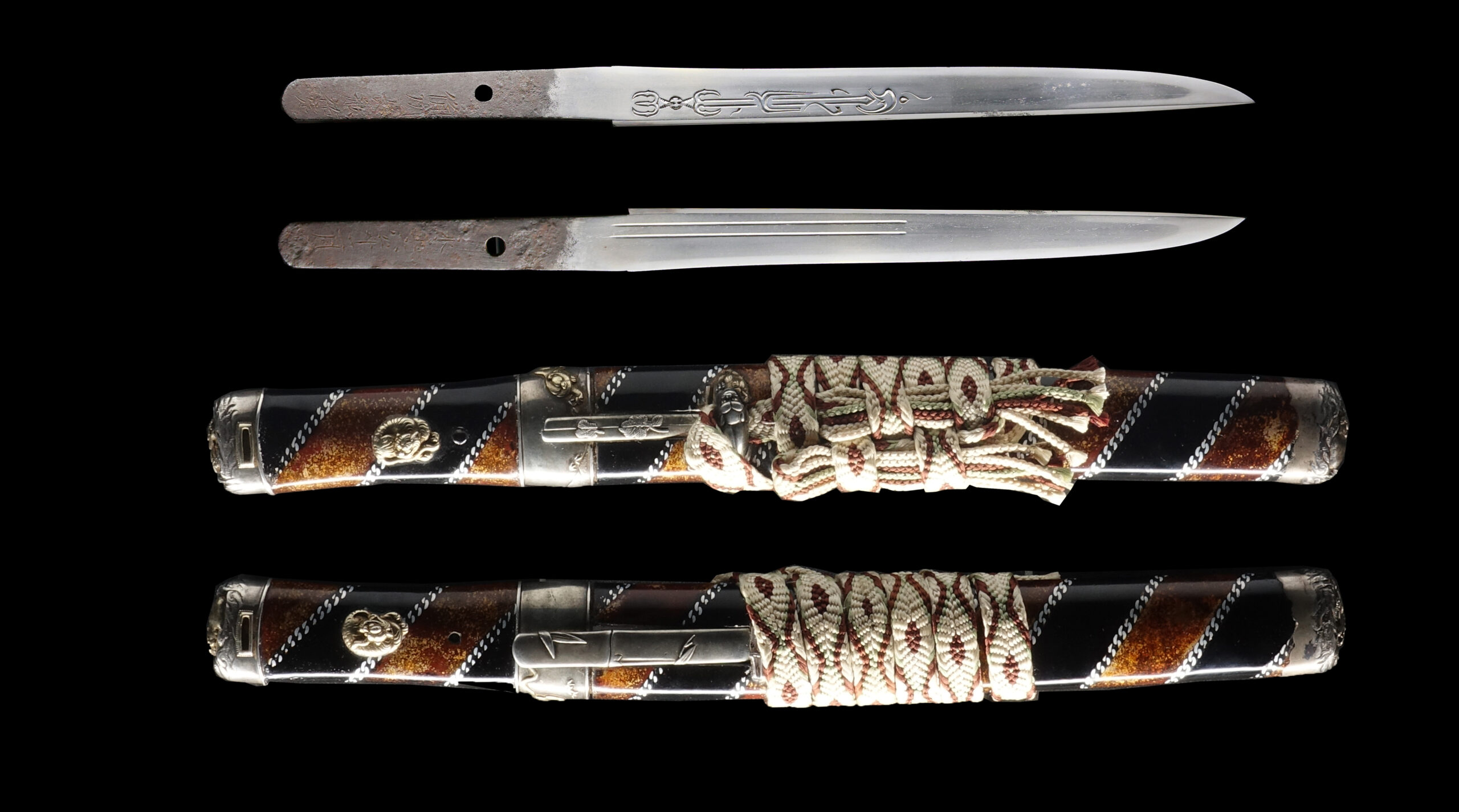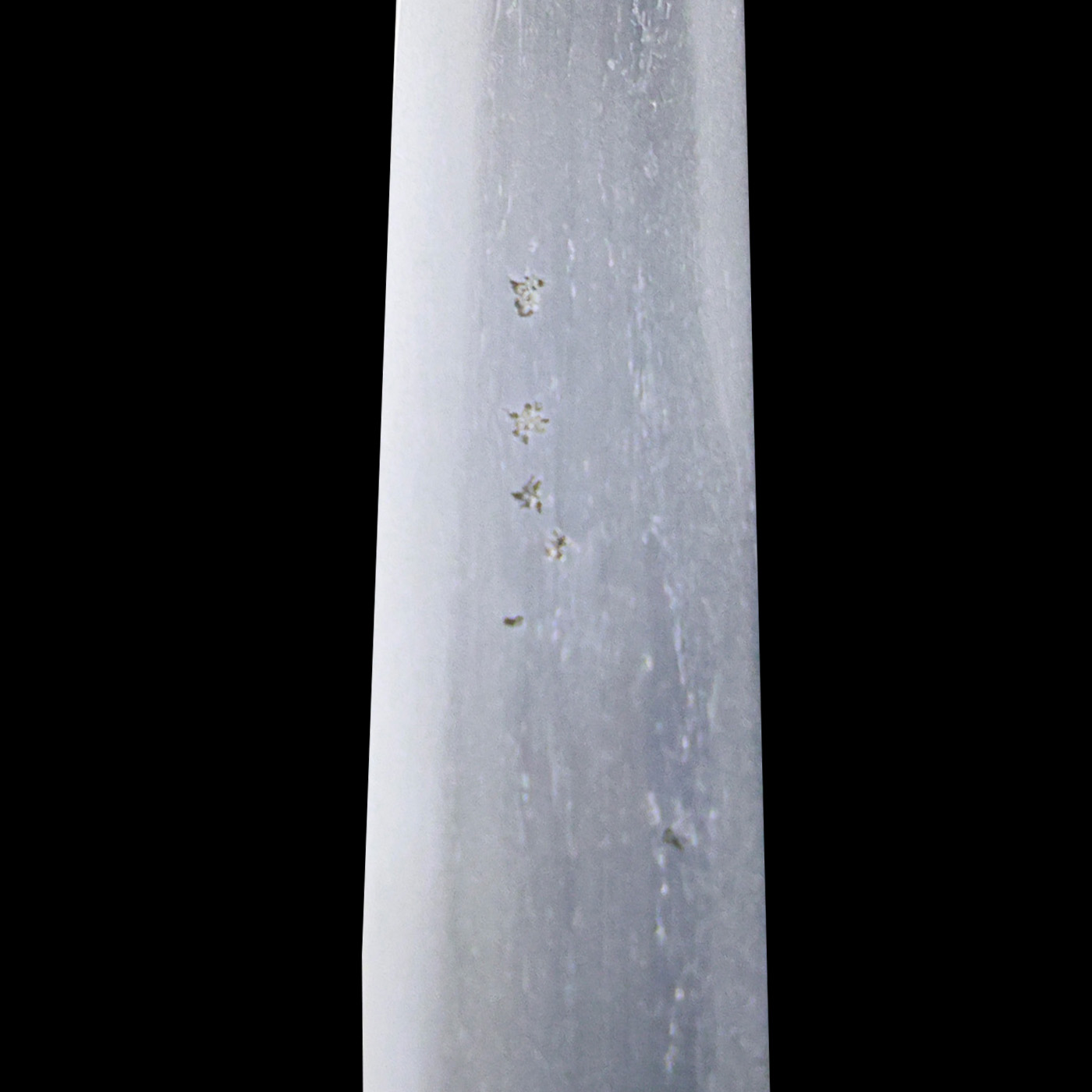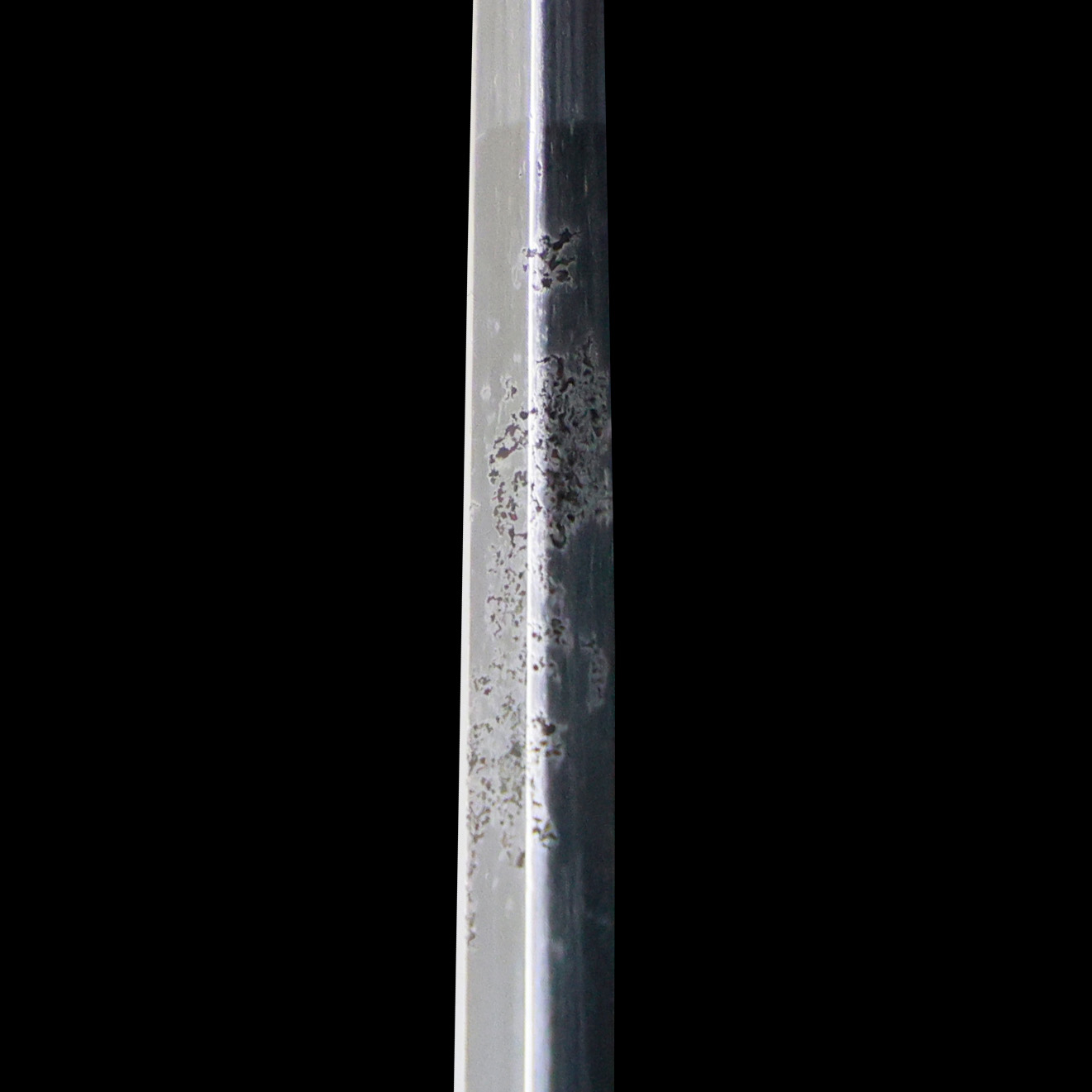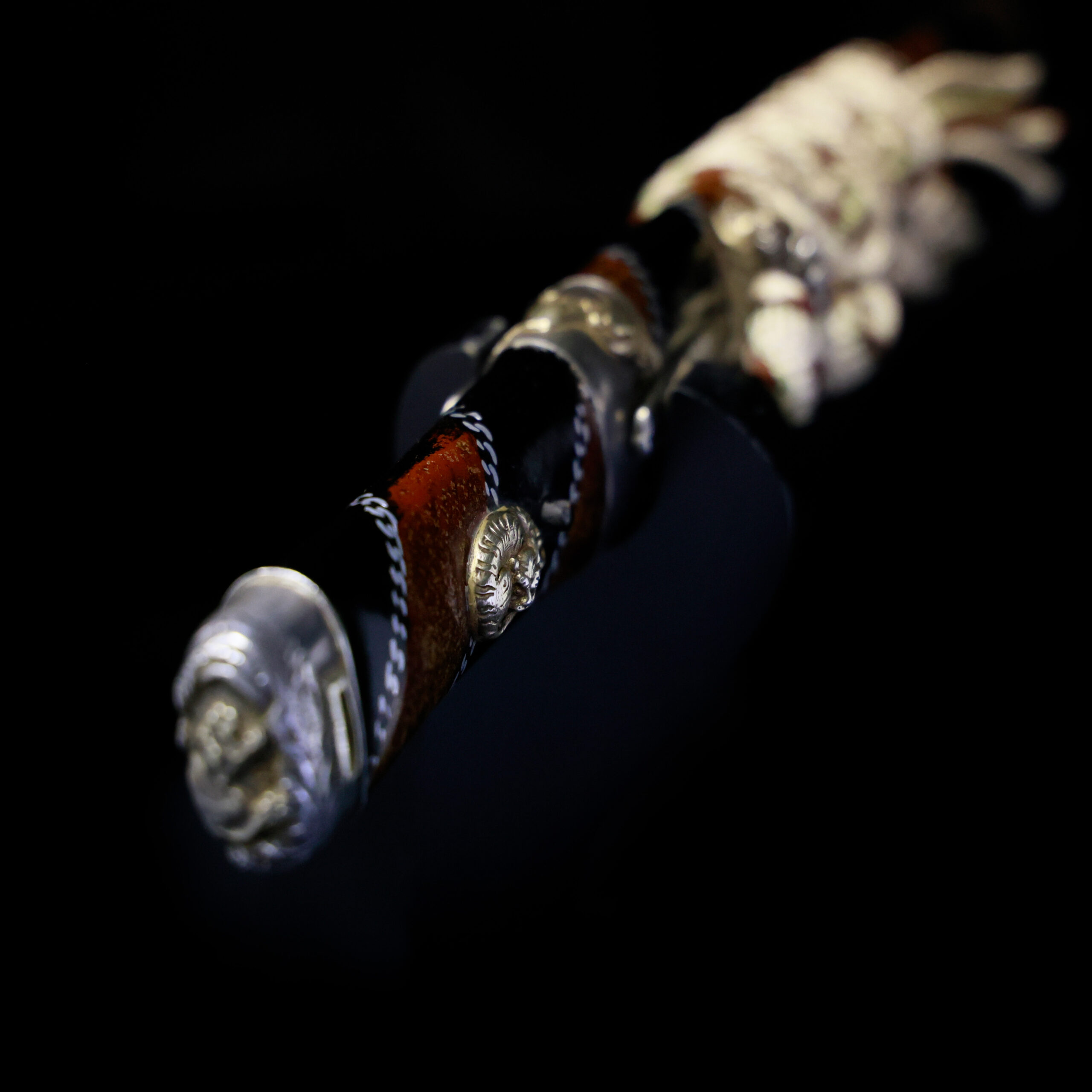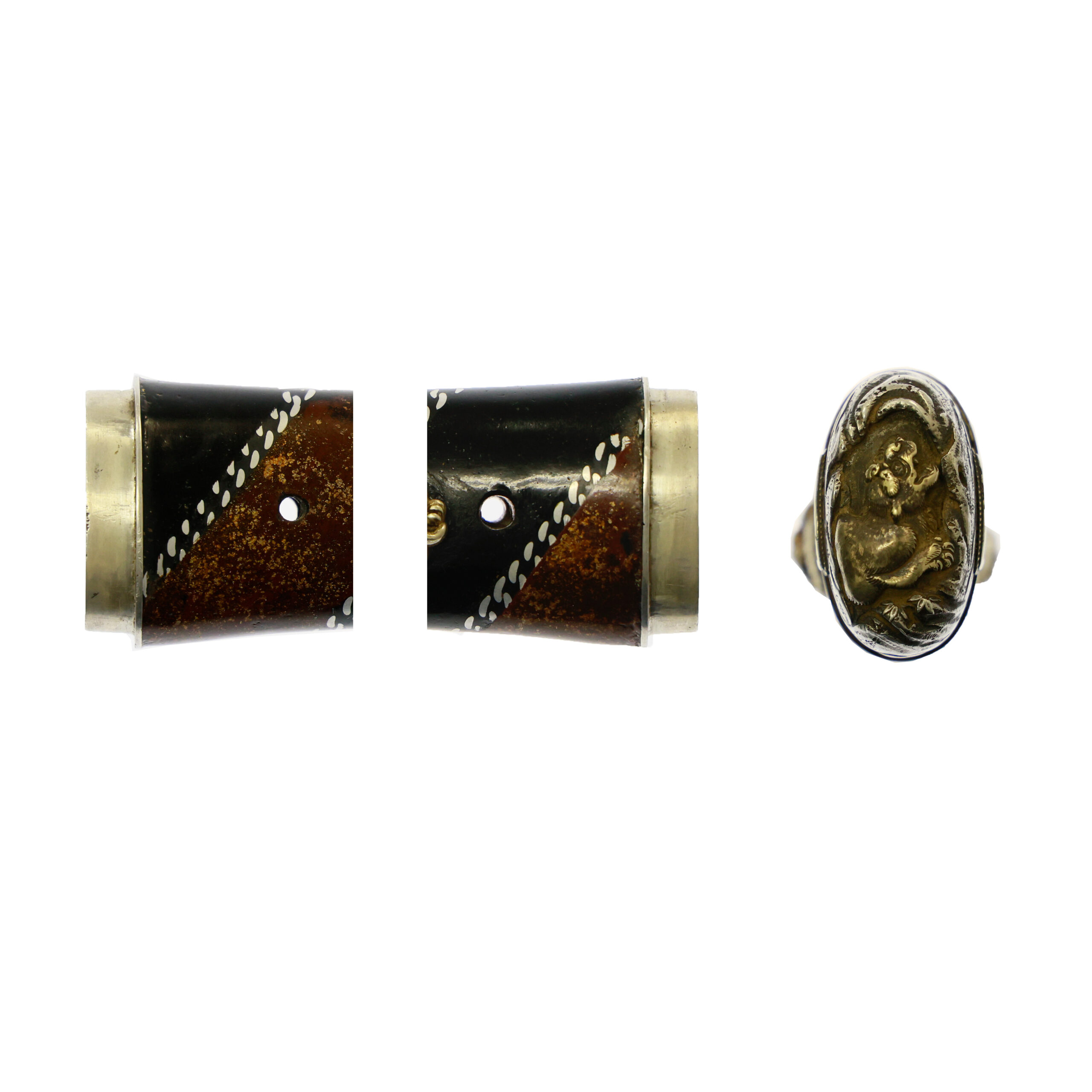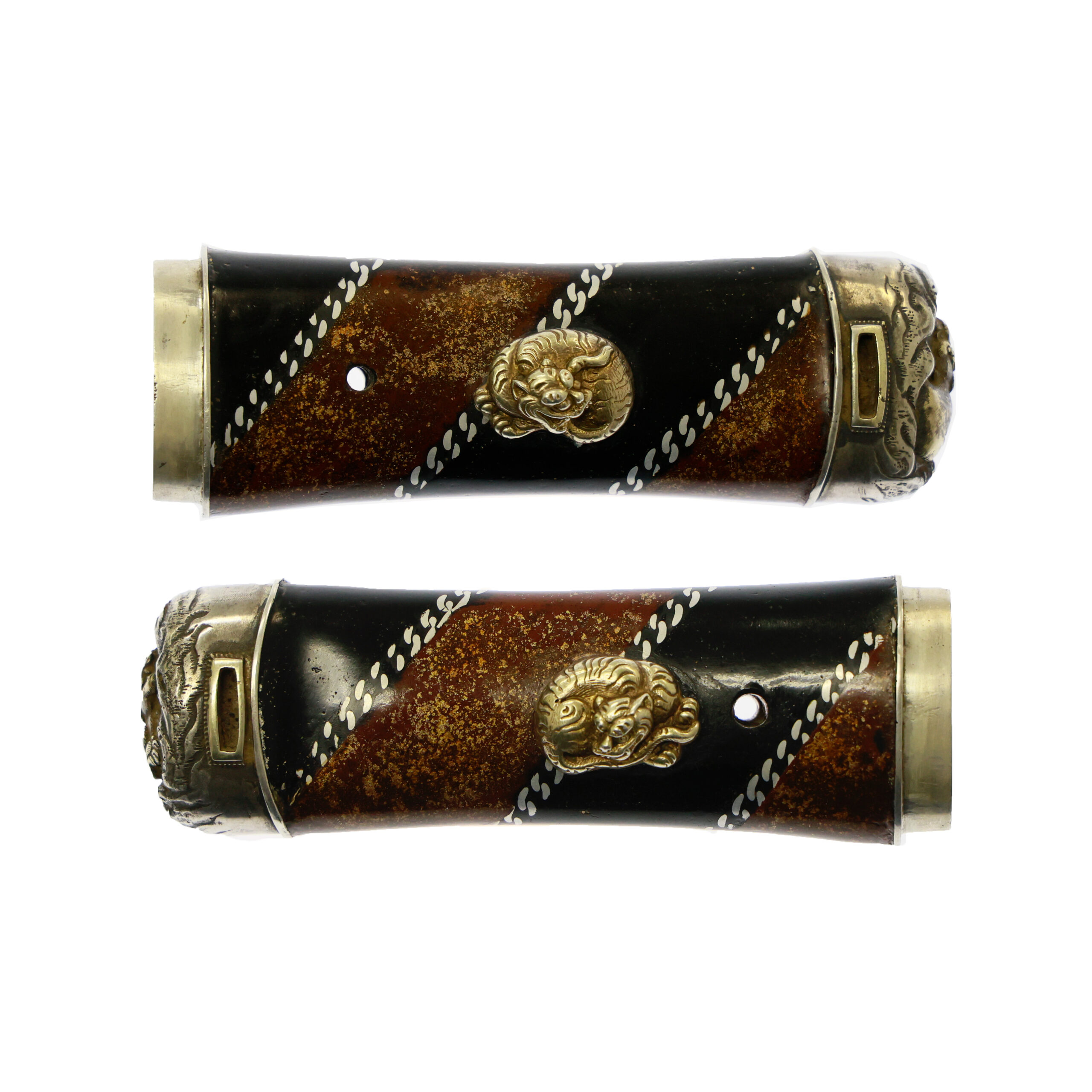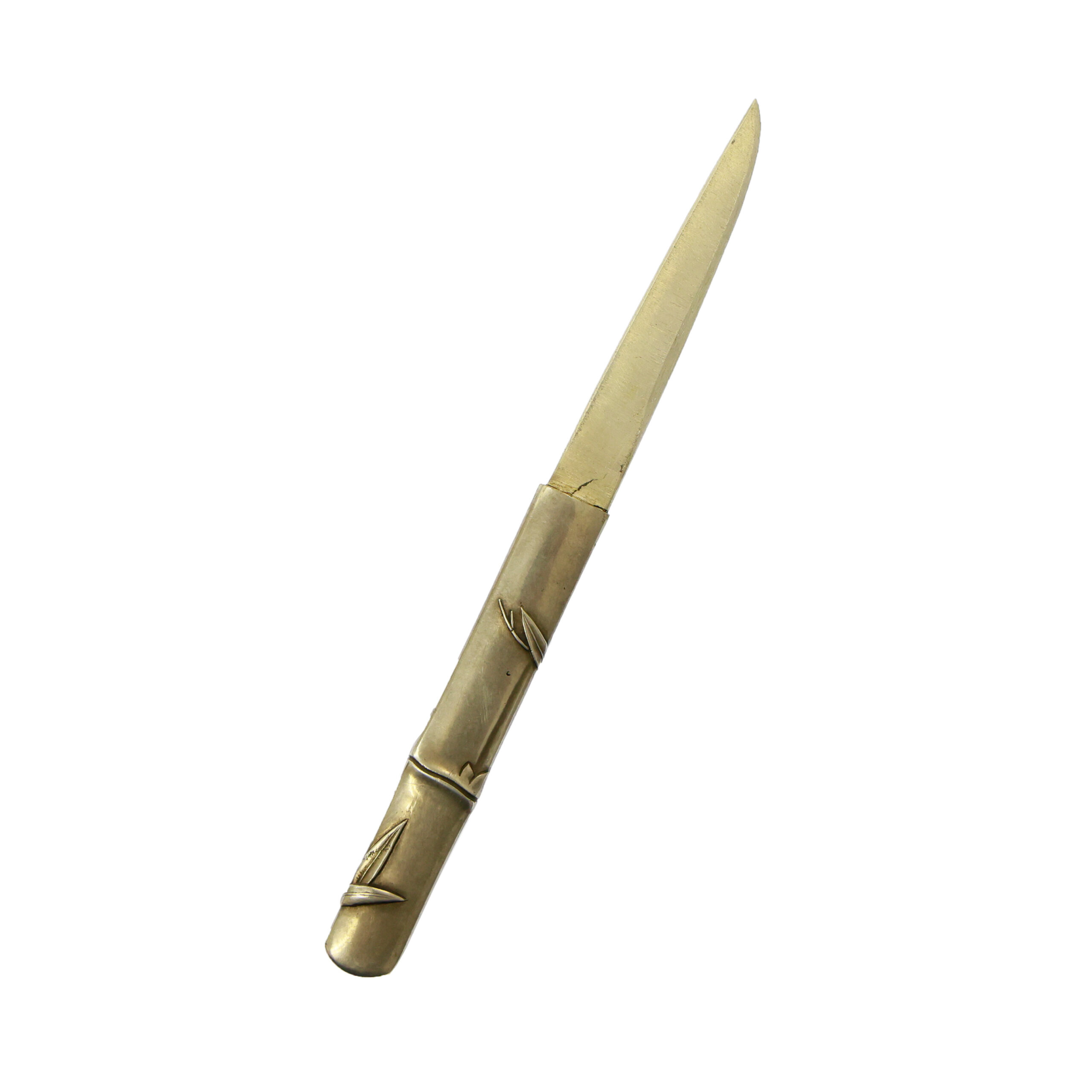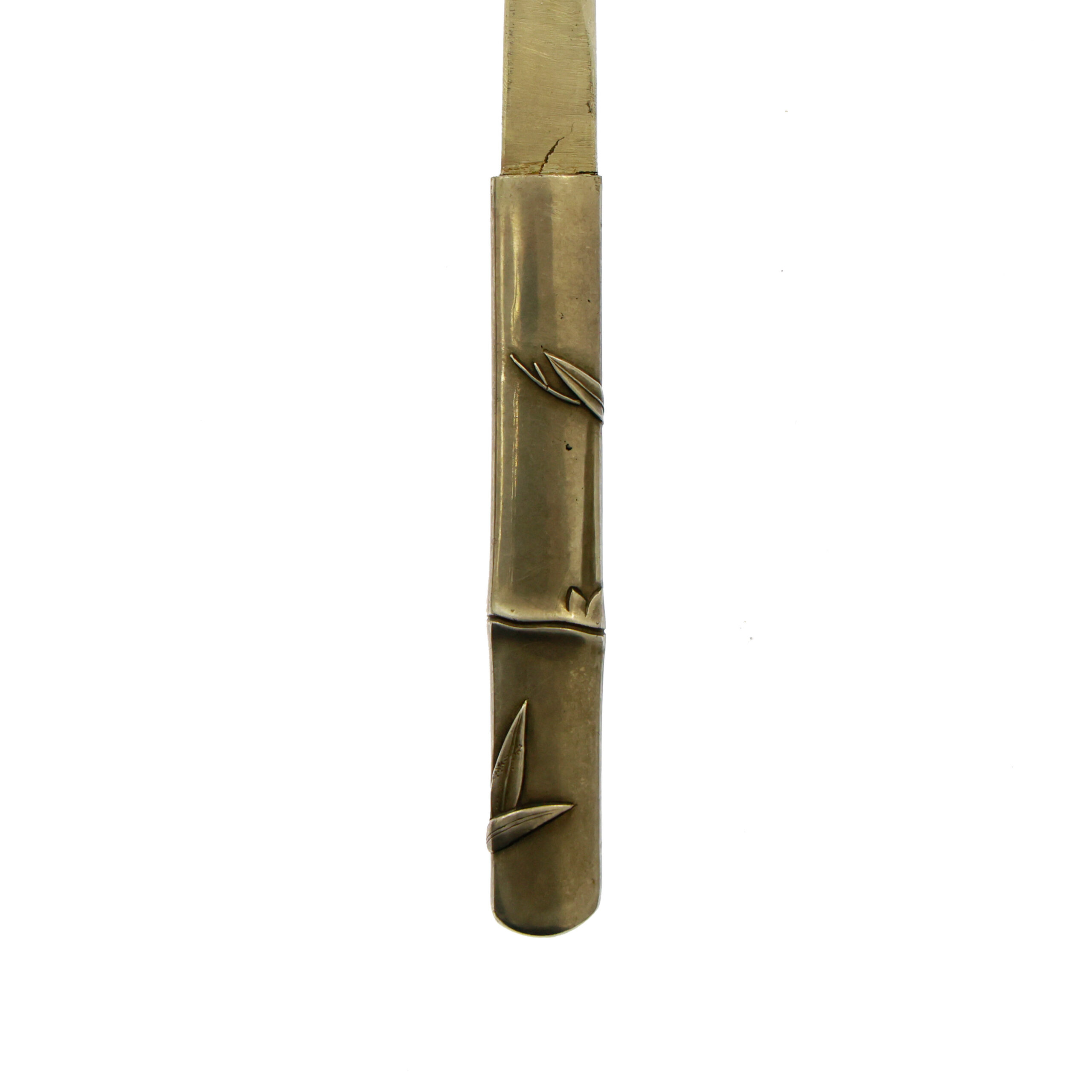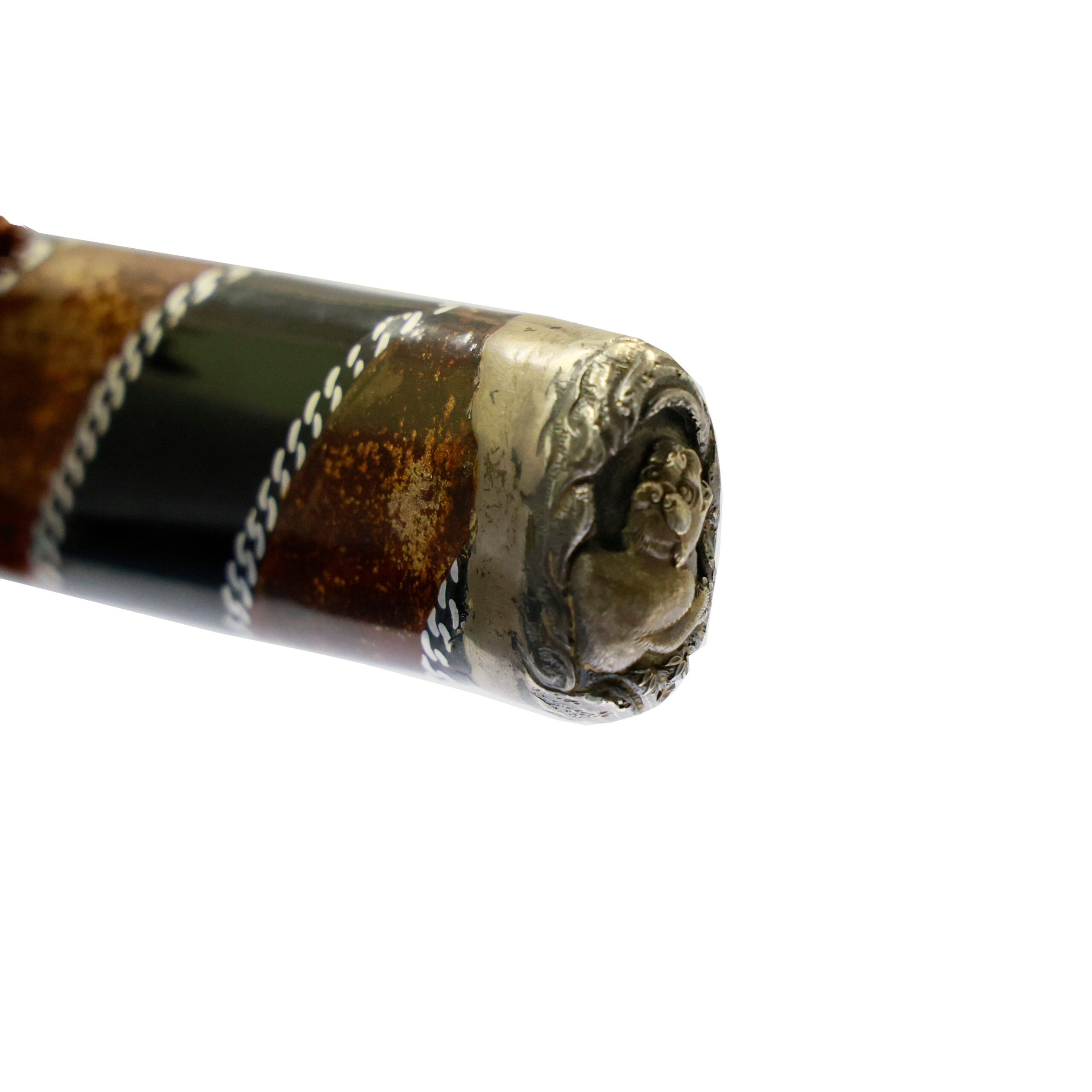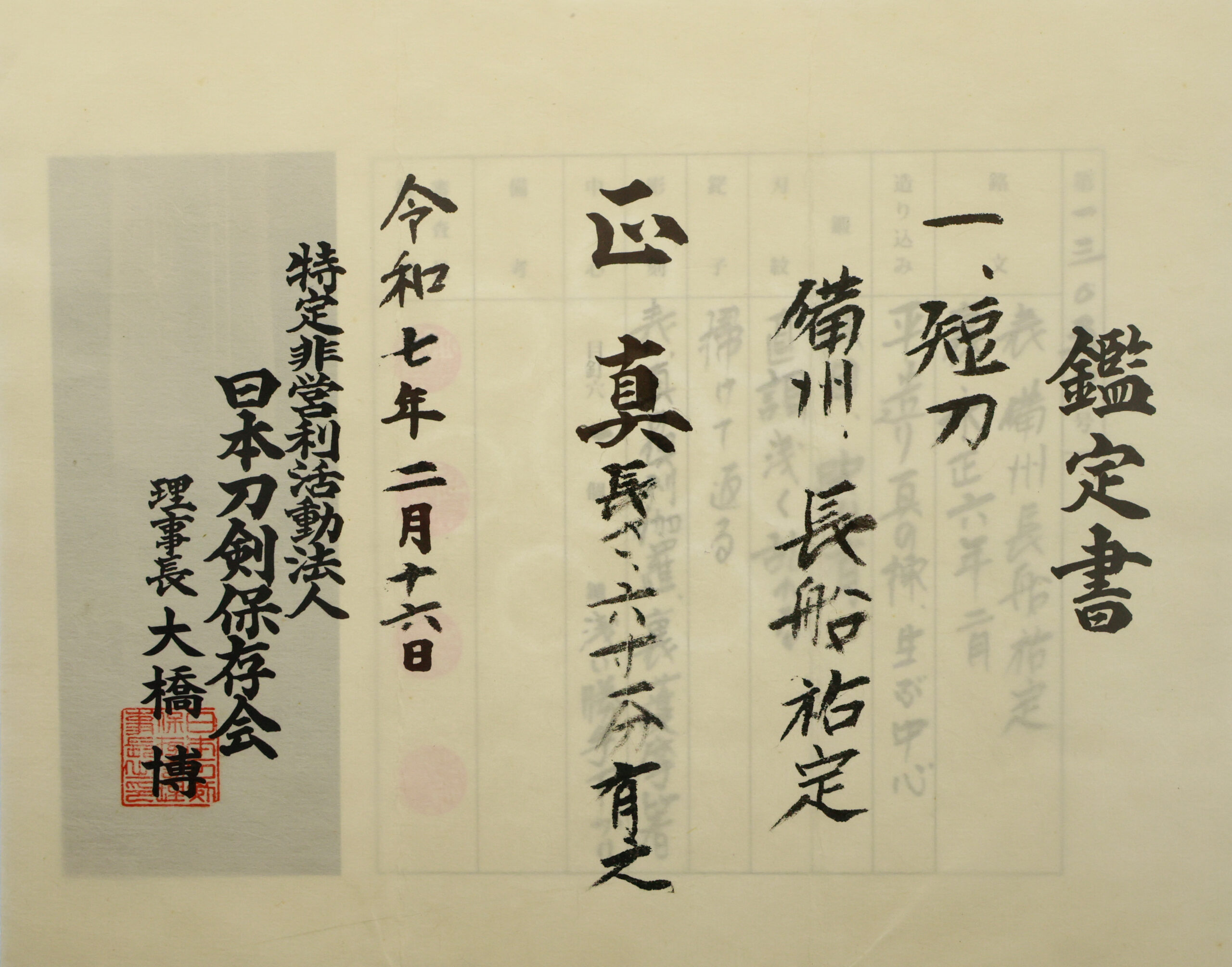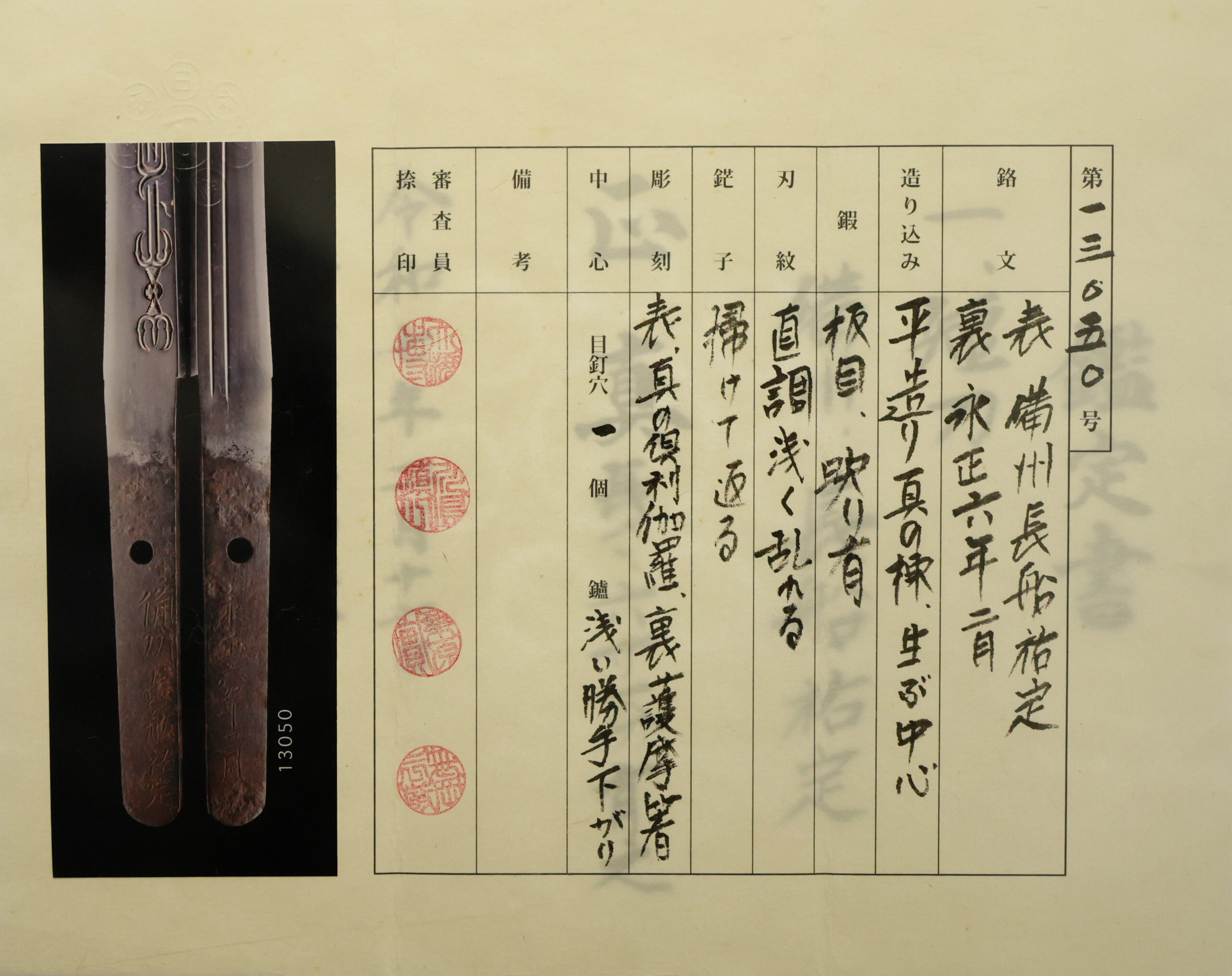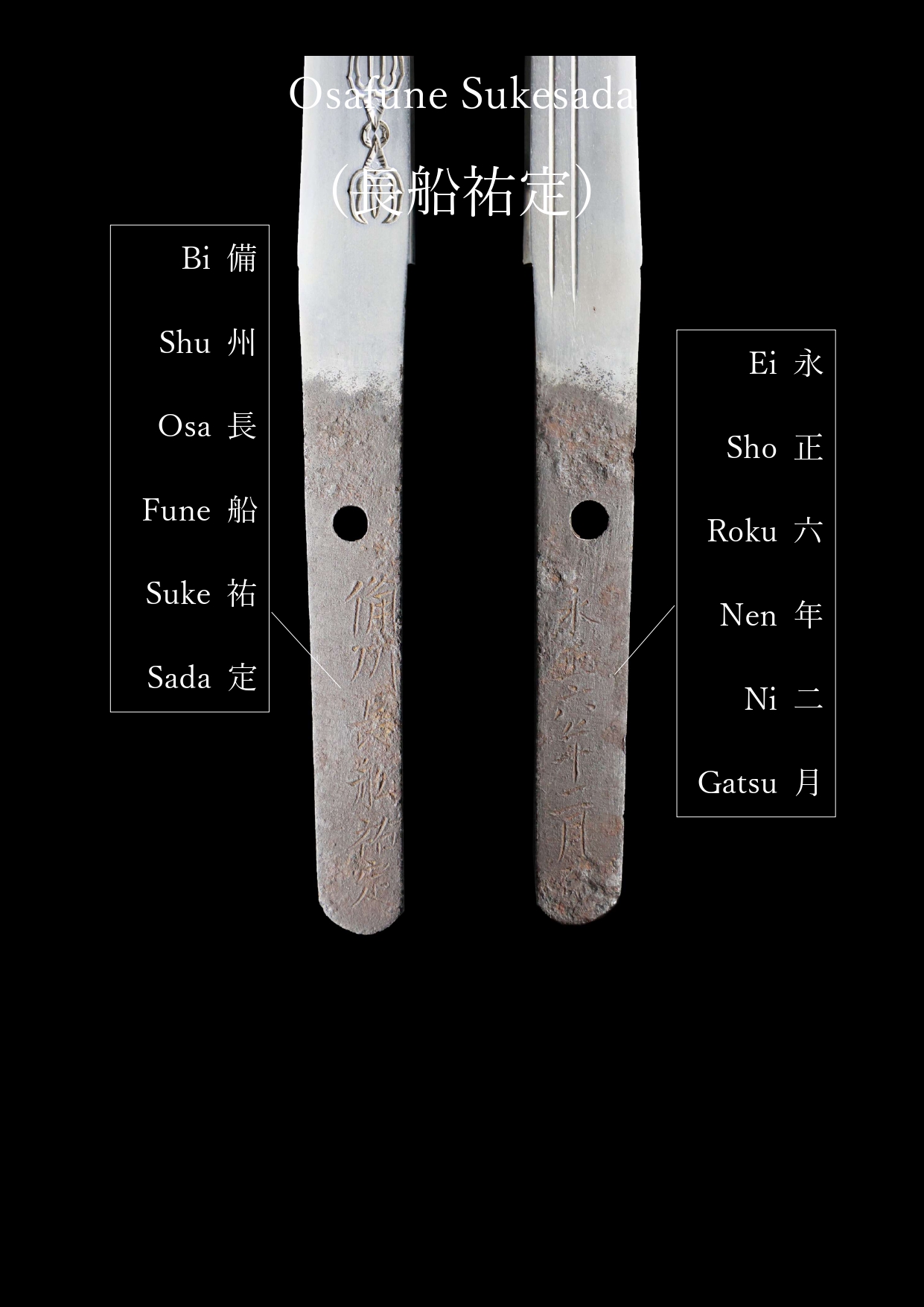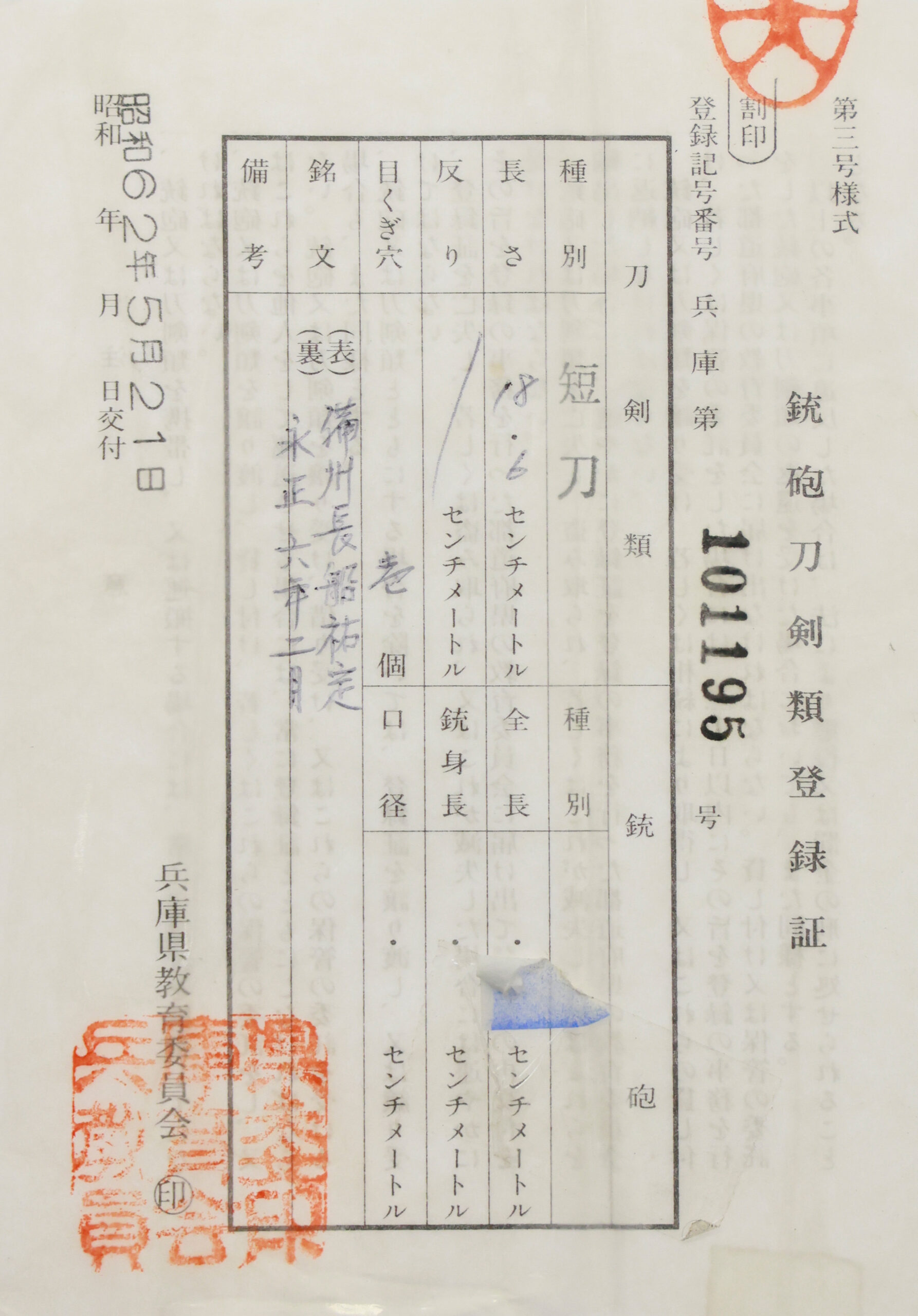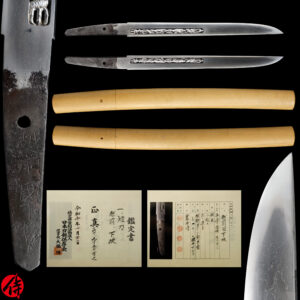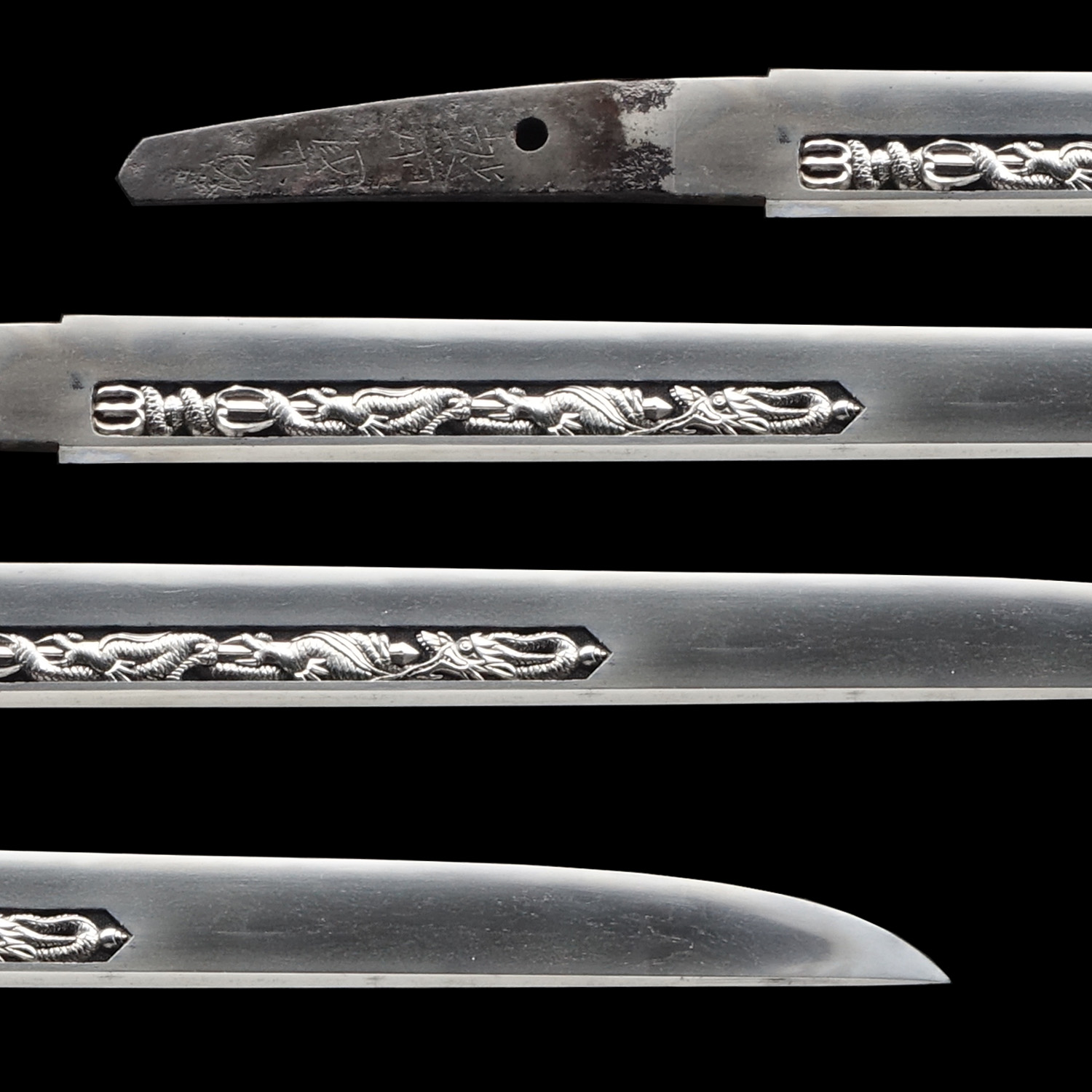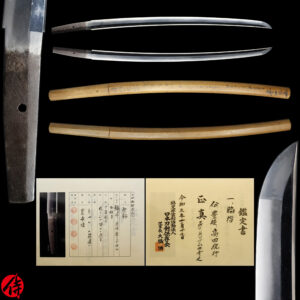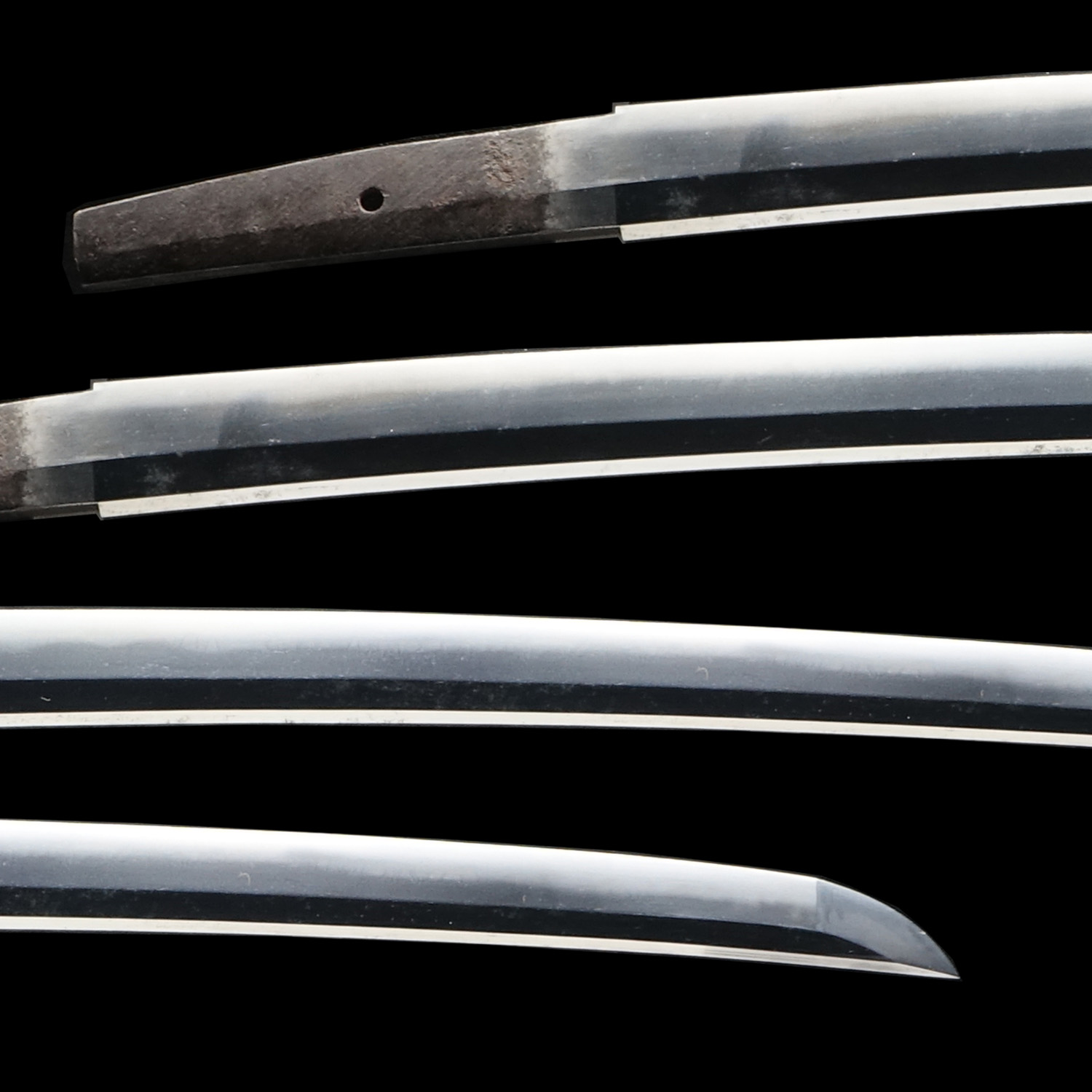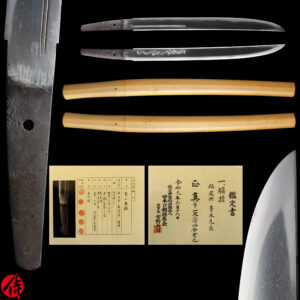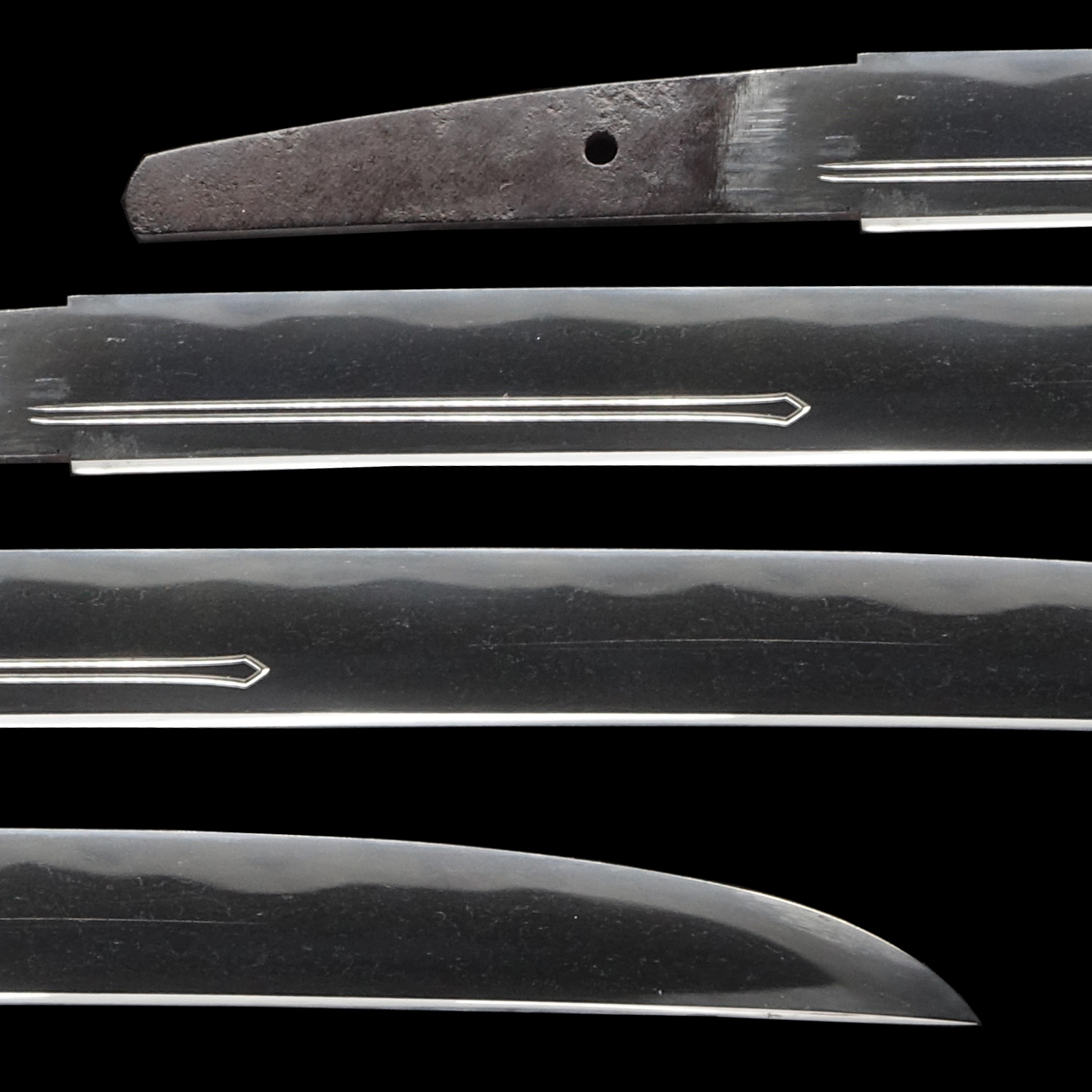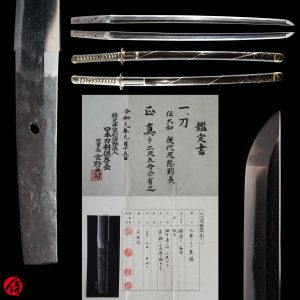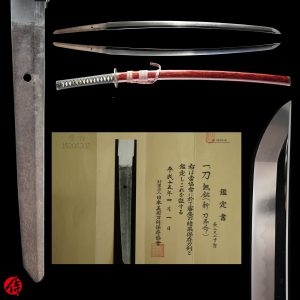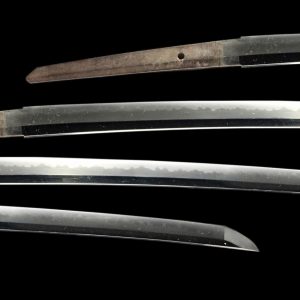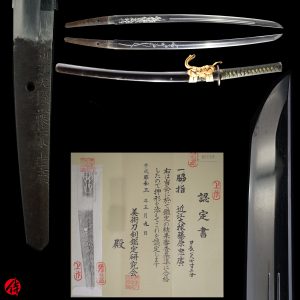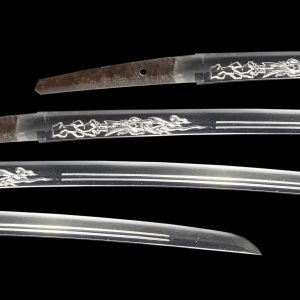Antique Japanese Sword Tanto Signed by Sukesada with NTHK Kanteisho Certificate
【Description】
This blade was signed by Osafune Sukesada (備州長船祐定) in the 6th year of the Eisho era (1509: the Sengoku period), according to NTHK appraisal. Bishu, also known as Bizen, is the name of the province located in Today’s Okayama prefecture. Osafune is one of the most prosperous schools in this province during the Muromachi period. Sukesada is his maker’s name.
Those who forged swords in the Bizen province (Okayama prefecture) at the end of the Muromachi period (1492-1569 A.D) are called Matsu Bizen (Matsu means the end). Sukesada school was one of the most famous schools, and it flourished for generations among Osafune schools (The head branch). There were various styles forged by the generations of Sukesada during this period. Approximately 60 swordsmiths used Sukesada as his maker’s name in the Samurai history. In that sense, the swordsmith’s name “Sukesada” worked as a kind of brand that attracted many Samurai.
The swordsmiths in Bizen produced many swords during the Muromachi period, as it was in the middle of the Sengoku period (Warring States period). The demand for weapons increased among strong feudal lords. It would be nice to have a piece forged in the Warring States period when there was so much rivalry between warlords. It was possible that this blade was ordered by a Samurai and he might have carried it on a battlefield.
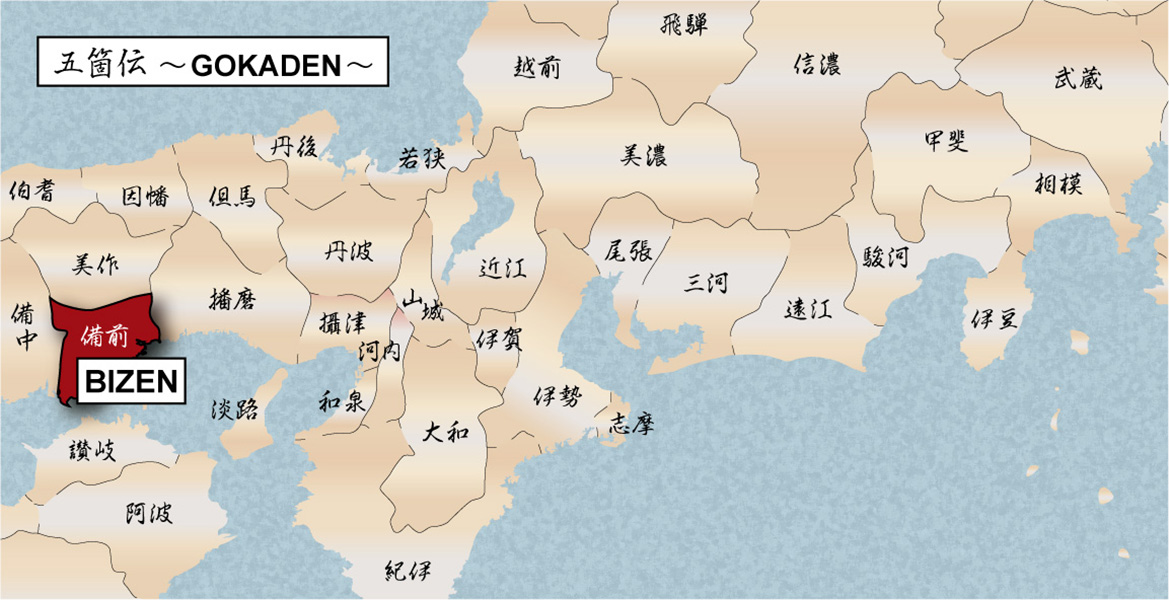
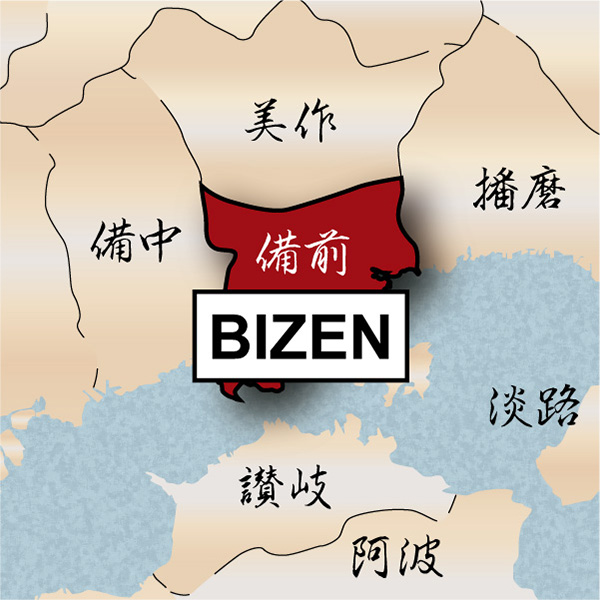
This History of Bizen Osafune School
It is said that Osafune school was founded by Mitsutada (光忠), who was active during the mid-Kamakura period. Bizen Osafune school was the biggest one of all other schools in Bizen province, and they received many orders from feudal lords or renowned Samurai. They were called Osafunemono and were beloved by Samurai warriors.
Among the swordsmiths who belonged to this school, Nagamitsu, Sanenaga, and Kagemitsu are known as Osafune Sansaku, the three renowned Osafune swordsmiths. There are also four other prominent swordsmiths who were from Bizen Osafune school. They are called Osafune Shiten-no, the four masters of Osafune school. Their names are Nagamitsu, Kanemitsu, Nagayoshi, and Motoshige.
BIZEN is located near the Chugoku Mountains, where iron sands, one of the essential materials for making Japanese swords, were abundant. Furthermore, BIZEN swordsmiths had close access to the Yoshi River, where they could find water and charcoal. This geological location contributed to the swordsmiths forging high-quality refined blades. We presume BIZEN was quite active in sword-forging from ancient times. It is said that BIZEN DEN was created by groups of swordsmiths there during the late Heian era (Late 12th century). These ancient swordsmiths in Bizen province are called Ko-Bizen (Old Bizen) swordsmiths. By inheriting the sword forging techniques from Ko-Bizen swordsmiths, the Bizen Osafune school flourished from the mid-Kamakura period.
Horimono (Engraving)
This blade features exquisite engravings (Horimono, 彫り物) on both sides of the blade.
On one side, an intricate carving of Fudō Myō-ō riding a dragon (倶利伽羅不動, Kurikara Fudō) is depicted. Fudō Myō-ō is a guardian deity in esoteric Buddhism, known as the “Immovable One.” He is revered for his role in repelling evil and guiding people toward the righteous path, making him especially venerated by samurai warriors.
The dragon depicted in this engraving is known as Kurikara Ryū-ō (倶利伽羅龍王), a dragon deity considered an incarnation of Fudō Myō-ō himself. Kurikara Ryū-ō is believed to be a divine protector, enveloped in blazing flames that burn away all obstacles and evil. While dragons are traditionally seen as powerful mythical creatures, Kurikara Ryū-ō embodies the very power of Fudō Myō-ō, cutting through ignorance and purging worldly desires. The image of Fudō Myō-ō riding atop the dragon symbolizes his absolute control over chaotic forces, guiding them toward justice and enlightenment.
Above Fudō Myō-ō, a Bonji (梵字) inscription is engraved. Bonji are Sanskrit characters used in esoteric Buddhism to represent Buddhas and Bodhisattvas, and the inscription on this blade is believed to invoke the divine protection of Fudō Myō-ō.
On the other side of the blade, an engraving of the Kurikara-ken (倶利伽羅剣) is featured. The Kurikara-ken is the sacred sword wielded by Fudō Myō-ō and is often depicted entwined with a dragon, symbolizing the power to cut through ignorance and evil. This esoteric Buddhist emblem was believed to provide protection and spiritual strength, and samurai warriors often incorporated such motifs into their swords as a source of mental and spiritual support. The design of this Kurikara-ken follows the form of the Sanko-tsuka-ken (三鈷柄剣, Three-pronged Vajra Sword), a sacred tool in esoteric Buddhism used in rituals, prayers, and for warding off evil.
*Please kindly note that although this is a tantō (short sword), it is stored in a wakizashi (medium sword) scabbard.
*Please keep in mind that there are a couple of Kitae Kizu as well as a few black rust spots on the blade. If you like to see the detailed condition, please feel free to contact us.
【Blade】
Cutting Edge Length (Nagasa): 18.6cm (7.3 inches)
Curvature (Sori): 0 cm (0 inches)

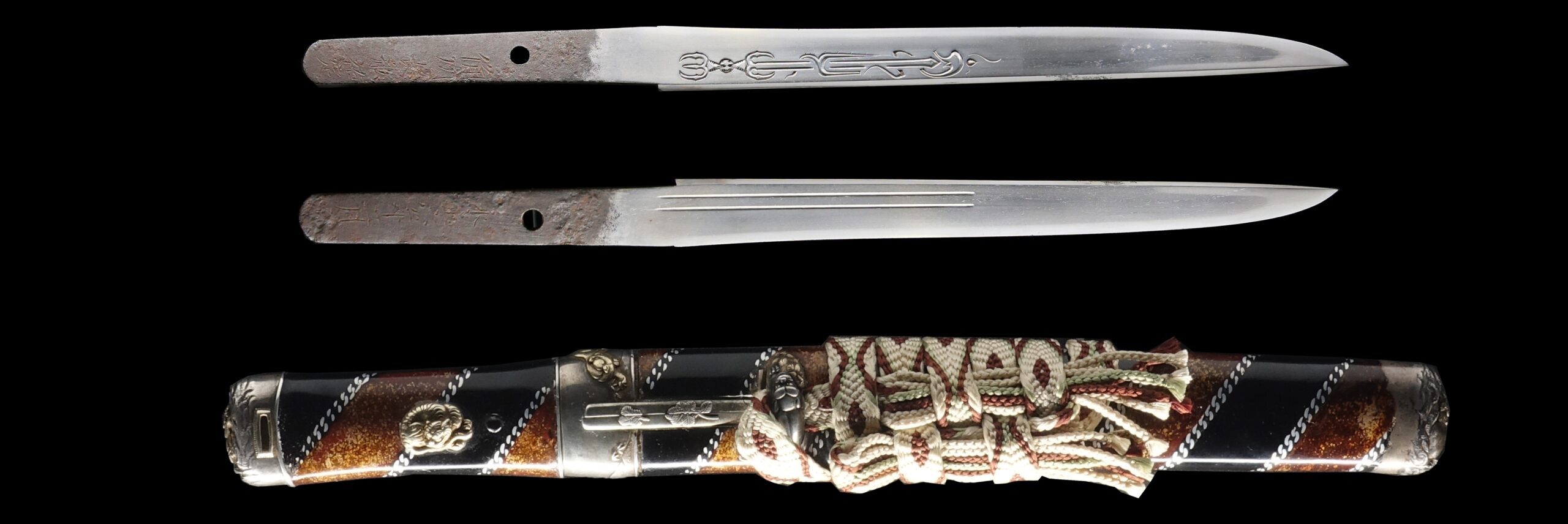
Hamon:
the crystalline structure which forms along the cutting edge of a blade as a result of the hardening process
Jimon(Jihada):
visible steel surface pattern created by folding and hammering during forging process

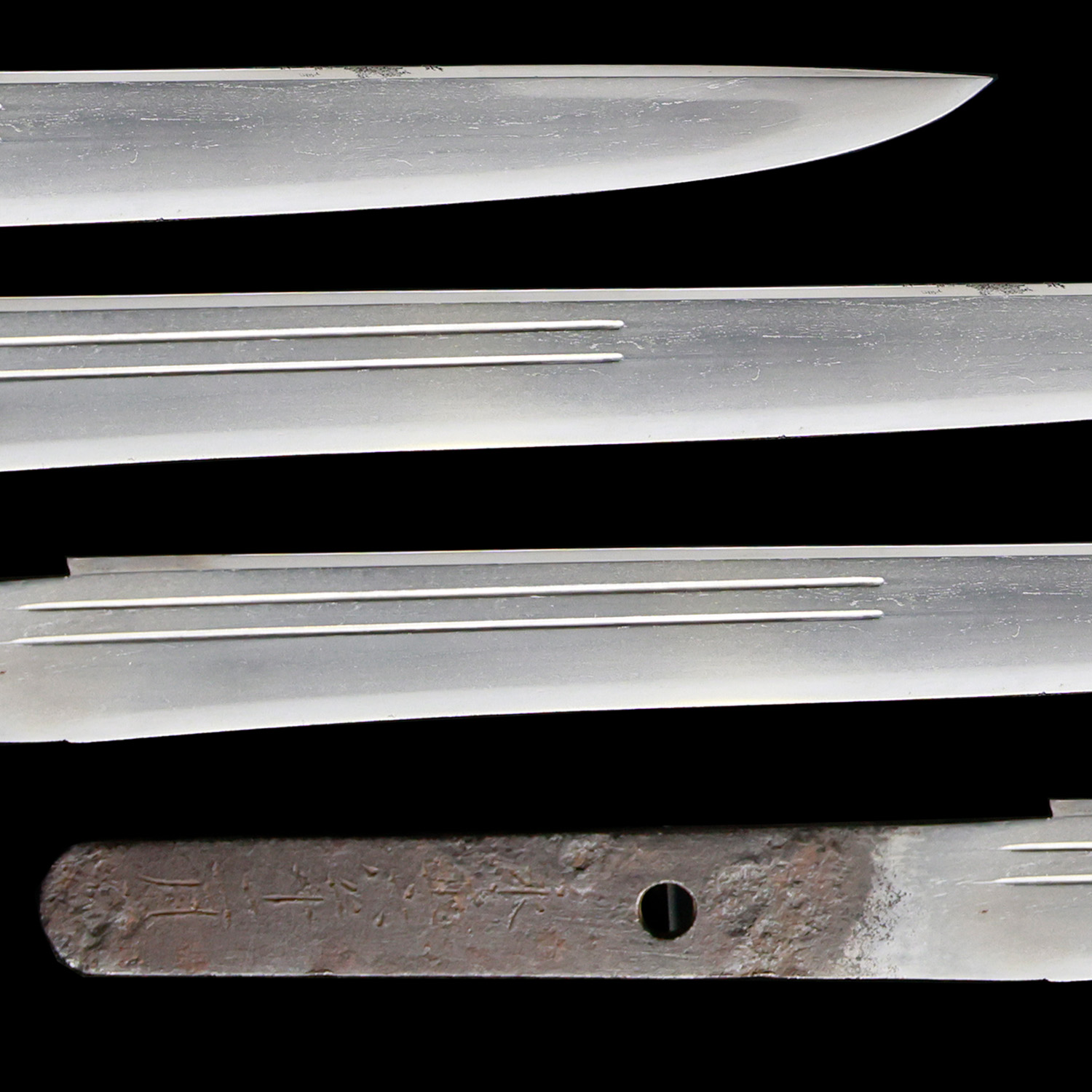
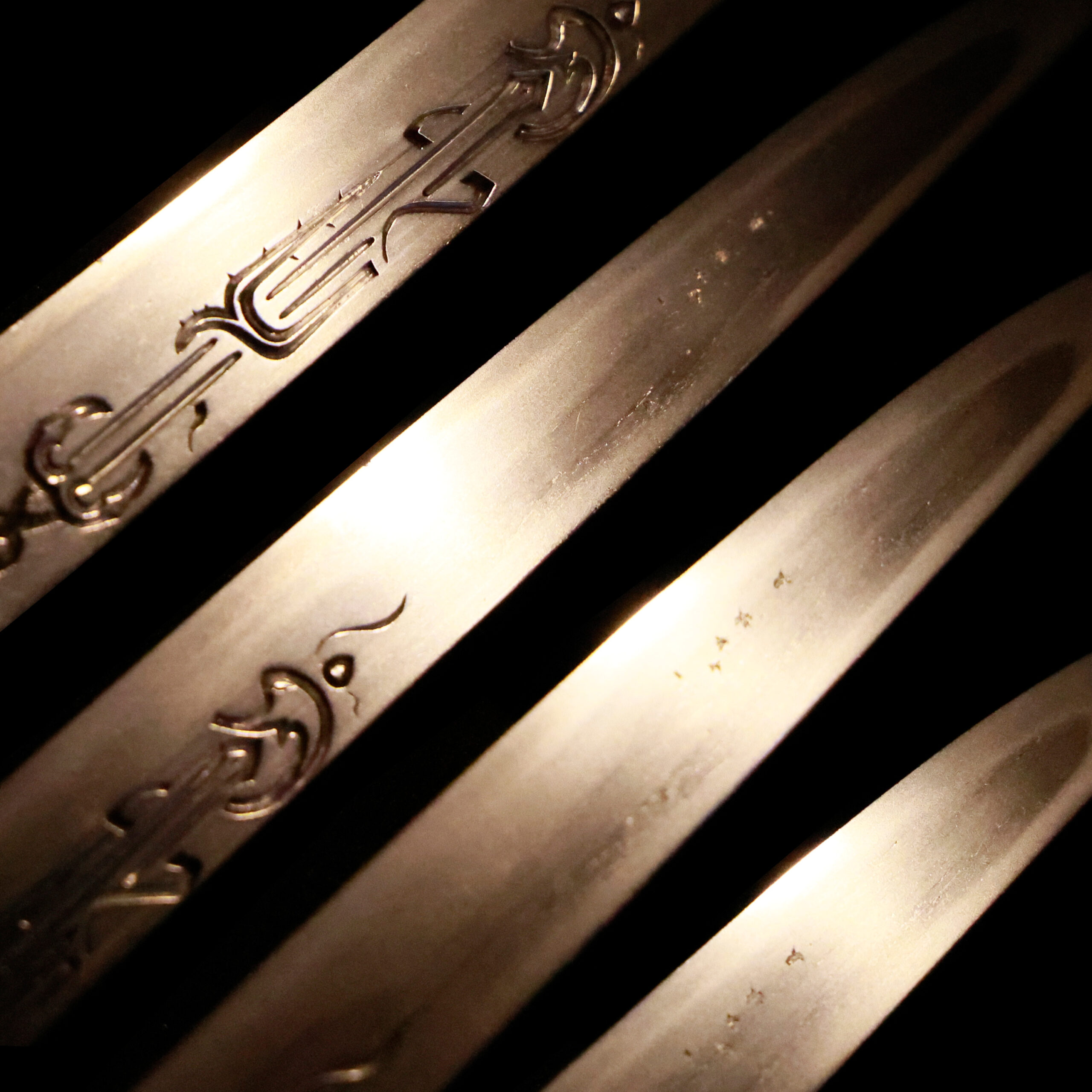
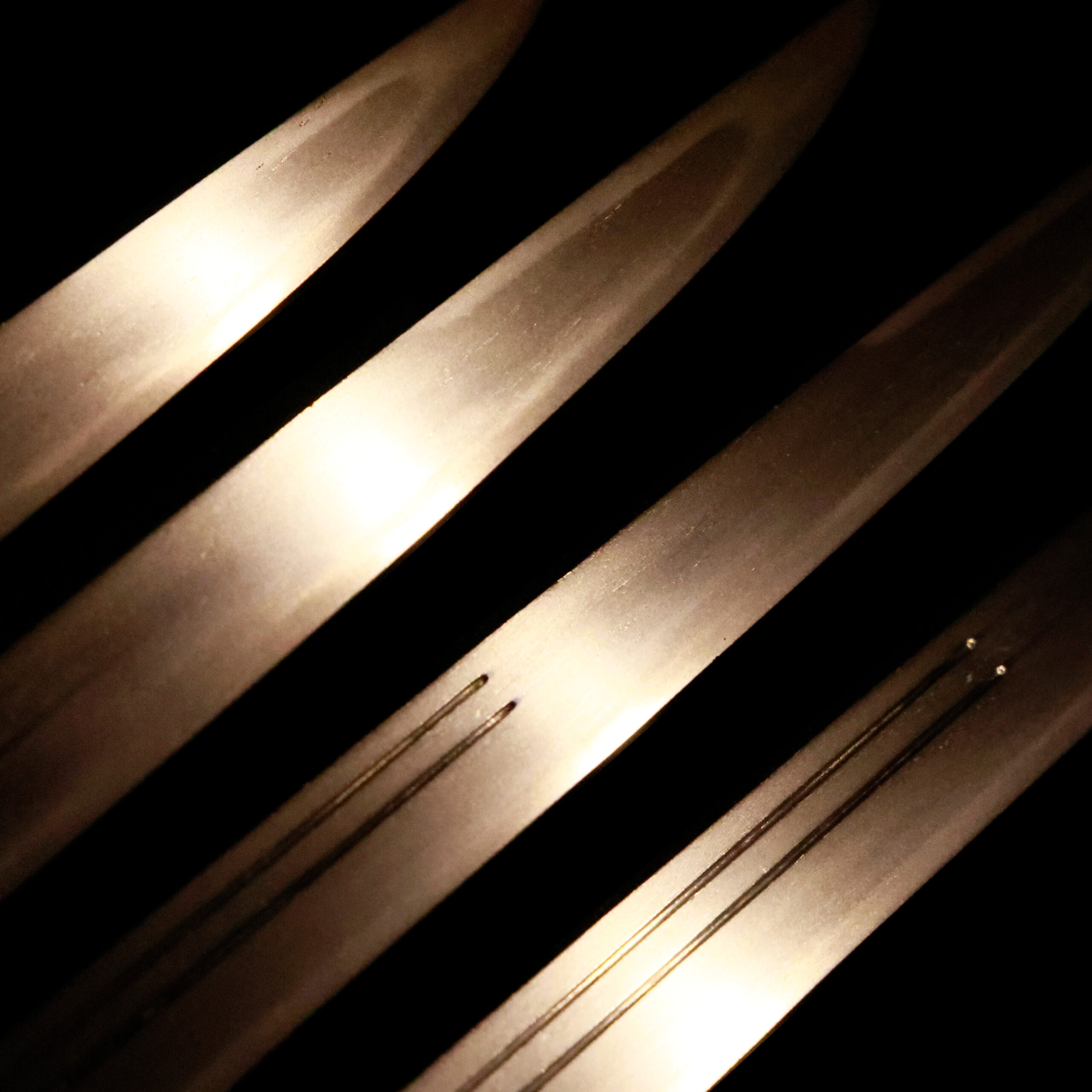
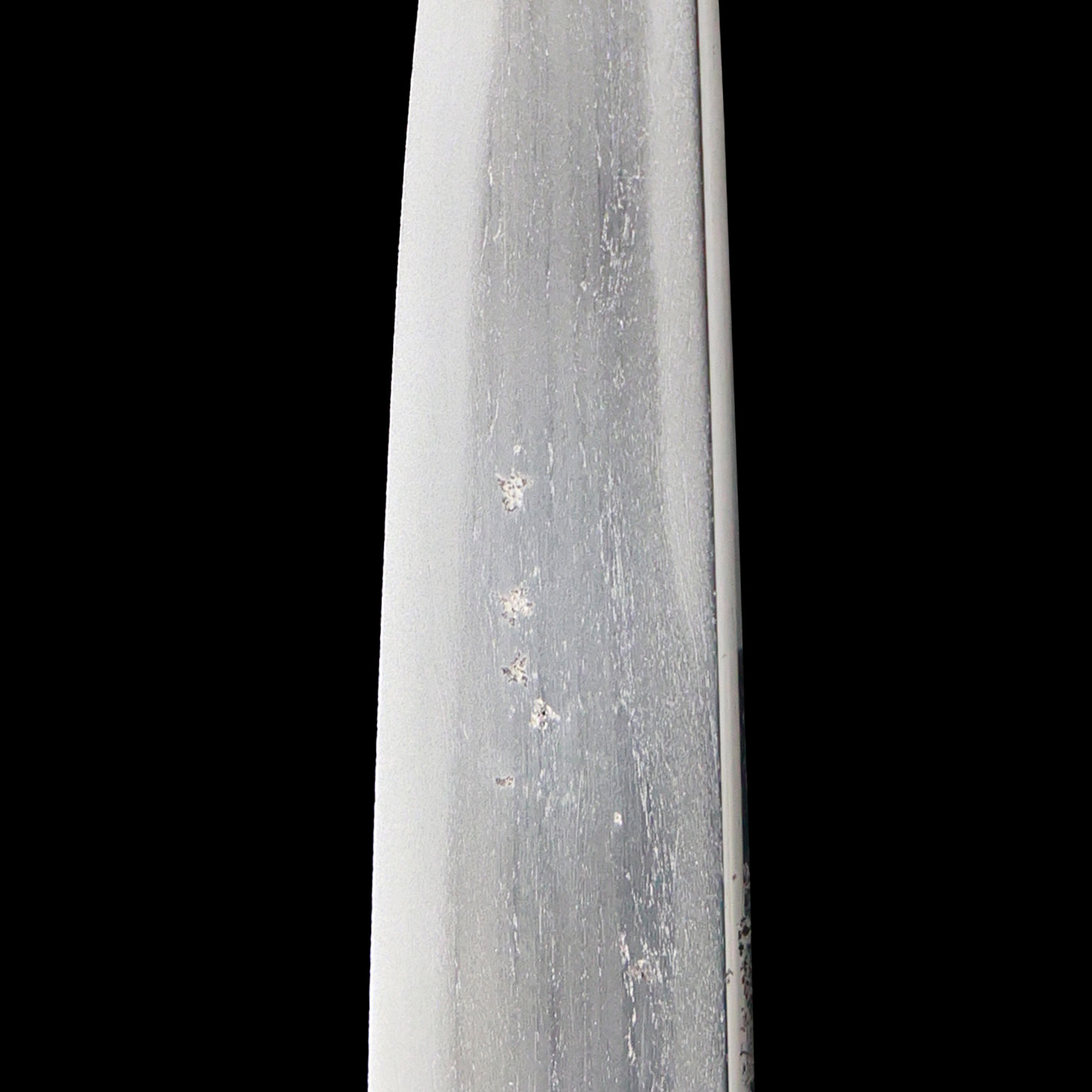
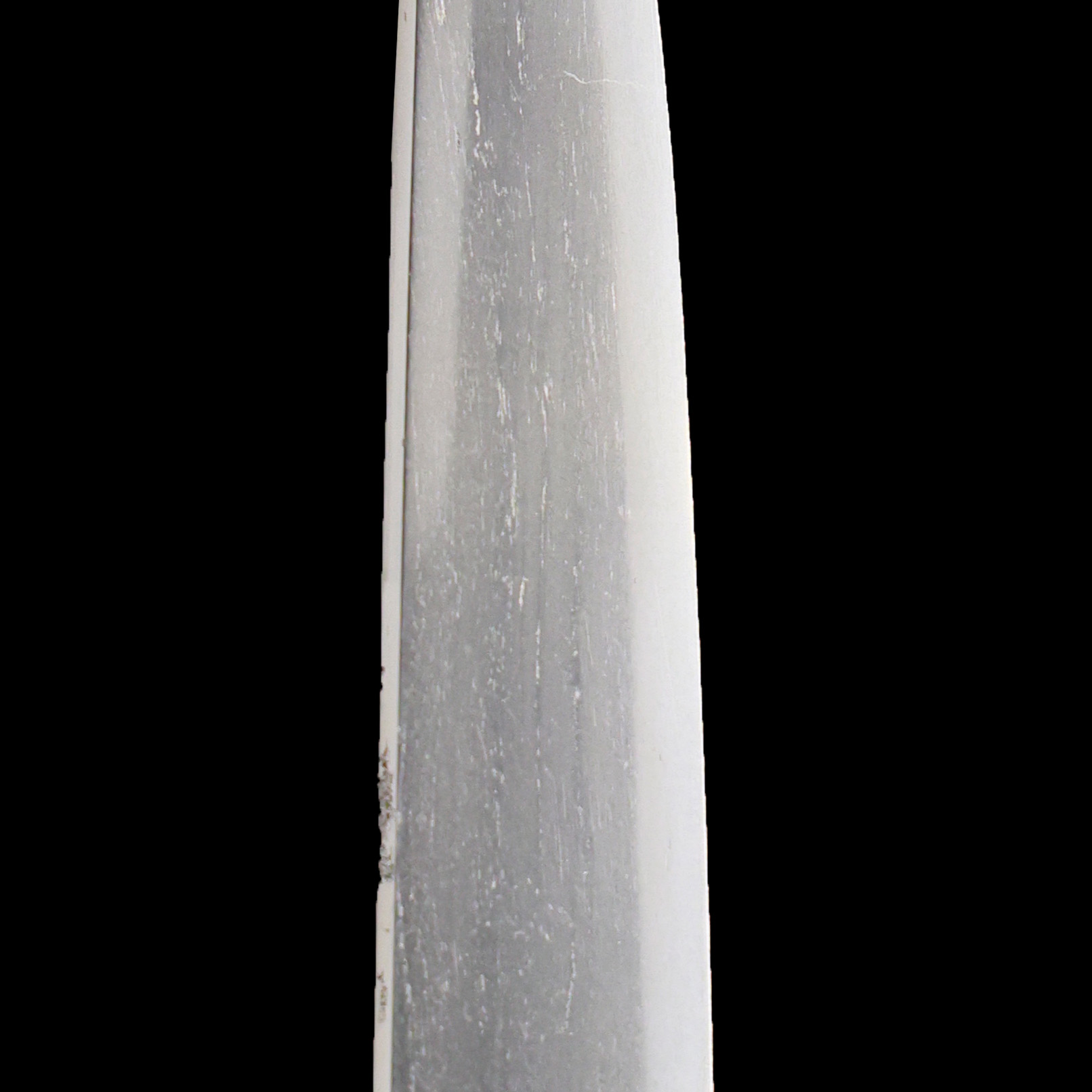
Kissaki: Kissaki is the tip of the Japanese sword.
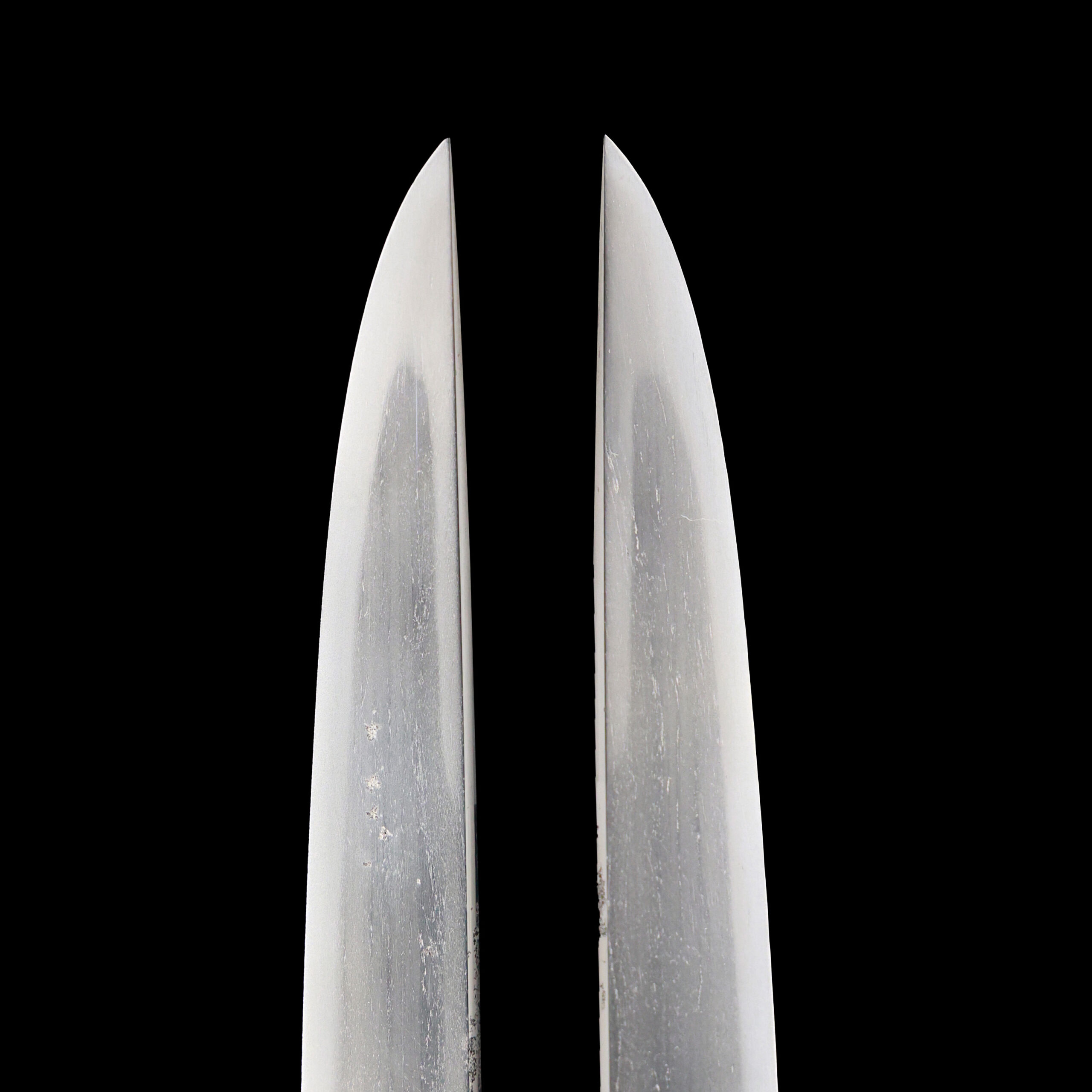
Nakago: Nakago is the tang of the Japanese sword.
Japanese swordsmiths left the black rust on the tang because it prevents red rust while the tang is in its handle. And the discoloration of the tang was created over time, and it is a great indicator for a Japanese sword specialist to estimate when the sword was forged.
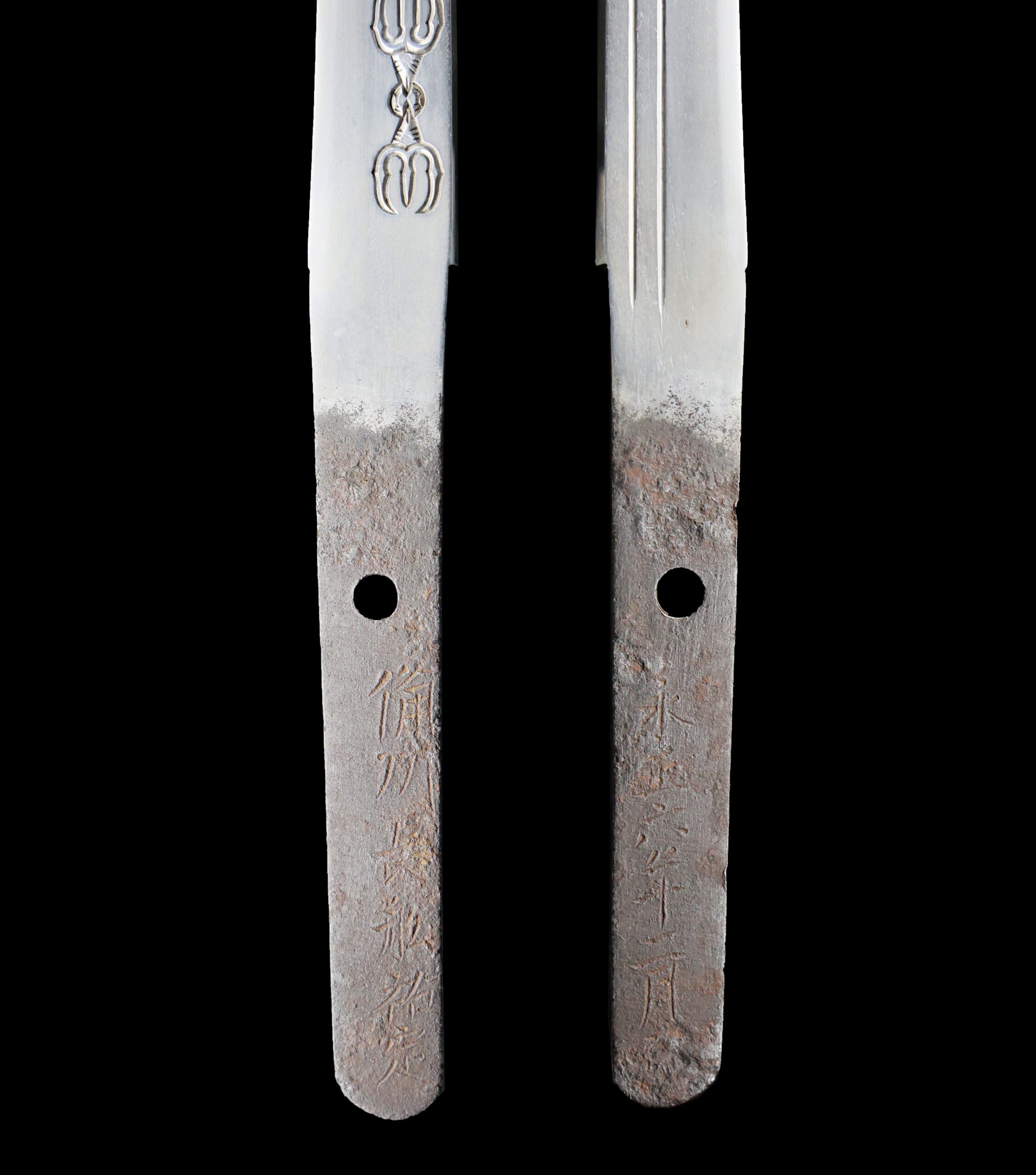
Koshirae:Koshirae is the mounting of the Japanese sword. There are several parts that consist of Koshirae such as Saya (Scabbard), Tsuka (Handle), Tsuba (Handguard).

Fuchi-Kashira:A pair of matching sword fittings that cover the upper and bottom parts of its sword hilt.
The theme of this fuchi-kashira (metal collar and pommel cap) is tiger and bamboo (竹に虎). This motif frequently appears in traditional Japanese paintings and decorations, alongside other symbolic themes such as peonies and Chinese lions (牡丹に唐獅子). The combination of tiger and bamboo represents strength and resilience, courage and flexibility, embodying the balance between power and virtue. This design is considered highly auspicious, symbolizing good fortune and protection.

Tsuka and Menuki:Tsuka is the handle of the Japanese sword and Menuki is its decoration.
The motif of this menuki is a komainu (狛犬), or “guardian lion-dog.” Komainu are mythical guardian creatures traditionally placed at the entrances of Shinto shrines in Japan to ward off evil spirits and negative influences.
As seen in this menuki, komainu are typically depicted in pairs—one with an open mouth representing “A” (the beginning), and the other with a closed mouth representing “Un” (the end). Together, they symbolize the beginning and end of all things, and are considered powerful protectors.
The inclusion of komainu in sword fittings reflects the owner’s wish for personal protection, strength, and spiritual guardianship.
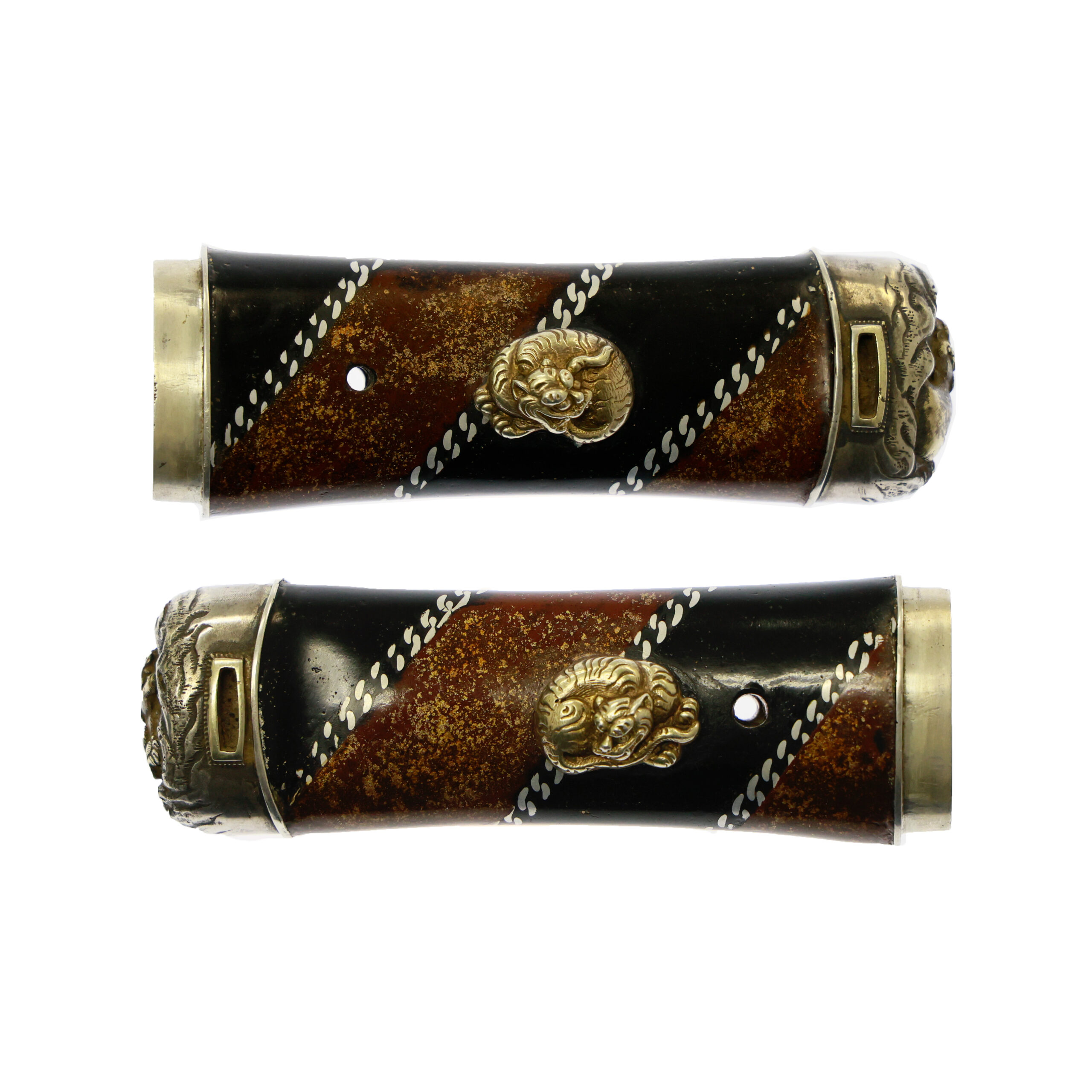
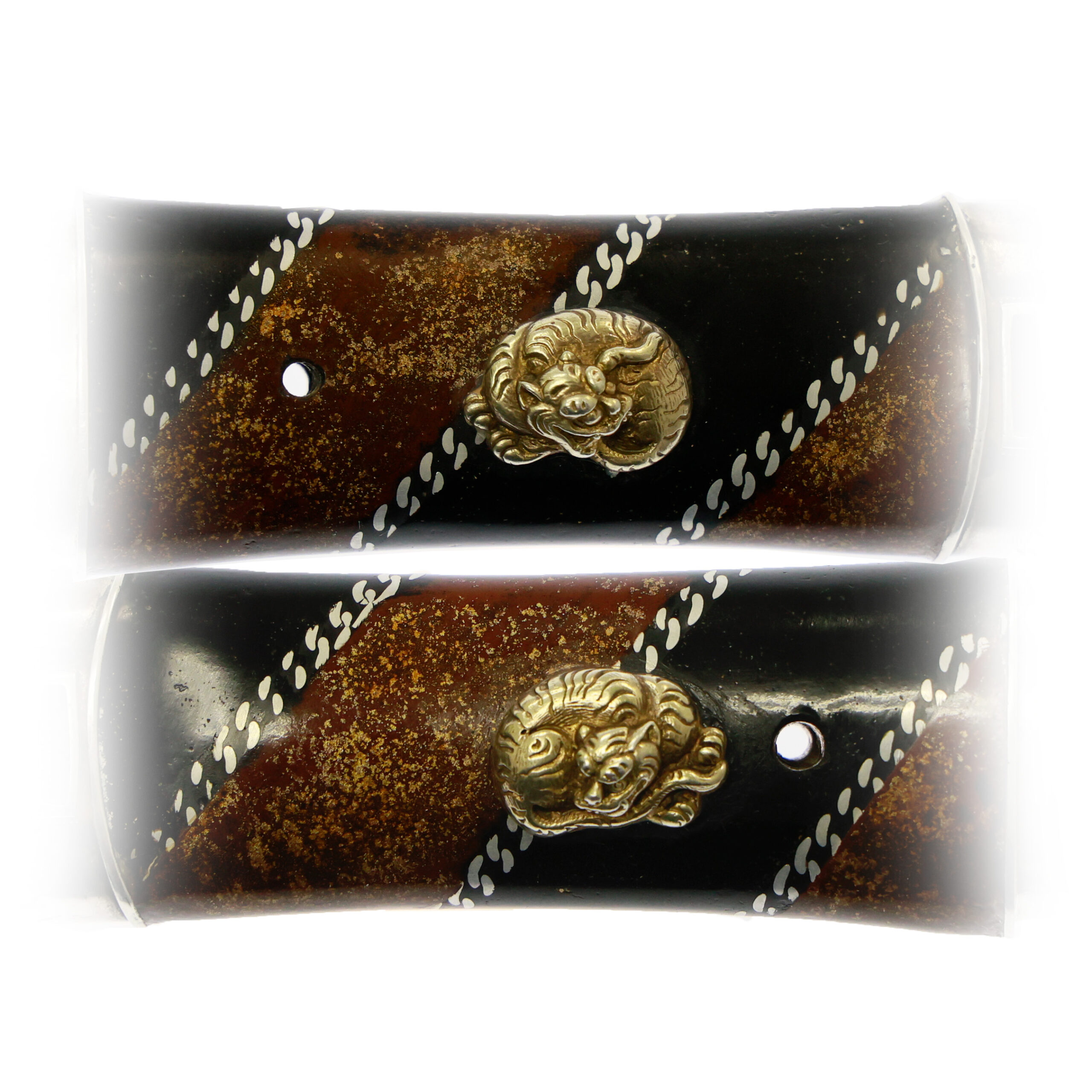
Habaki:Habaki is the equipment to make the blade not touch its scabbard inside. It prevents the blade from getting rusty and chipped.

Kozuka:Kozuka is a small knife stored in Kozuka Hitsu(groove of the sheath of the Japanese sword).
This kozuka features a design of bamboo. Bamboo grows straight and tall towards the sky, and this quality makes it a symbol of nobility and strength. Additionally, bamboo is hollow inside, which was thought to represent innocence. According to a Chinese legend, the phoenix (鳳凰, Fenghuang) eats bamboo fruits, which led to bamboo being regarded as a sacred plant. Moreover, since bamboo retains its green color even in the cold winter, it is associated with eternity and longevity. The bamboo pattern is one of the most familiar and cherished motifs in Japanese design, representing deep cultural significance since ancient times.
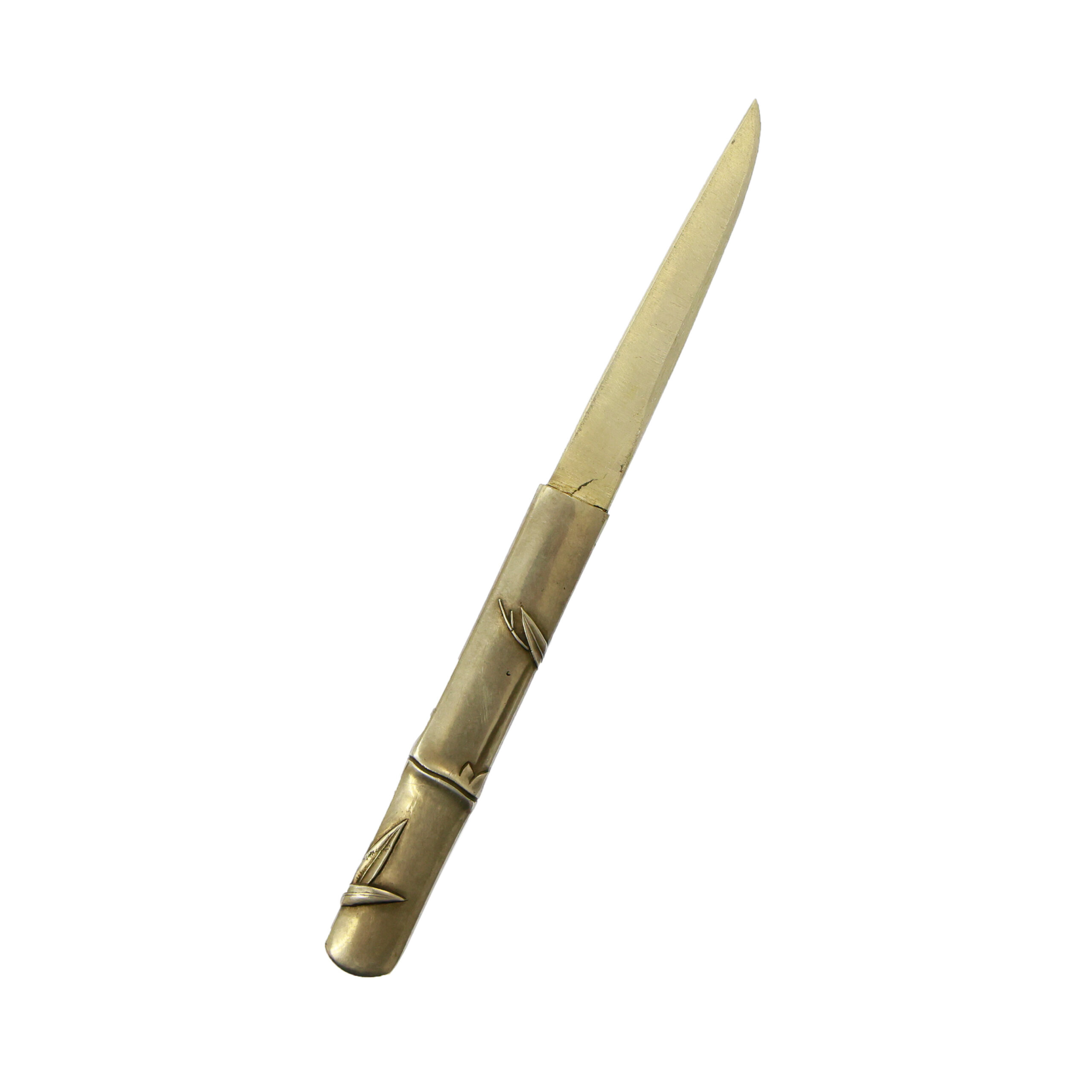

Kougai:Kougai is the equipment for Samurai to arrange or fix his hair style.
This item is an antique Kougai (笄), which was used to arrange or fix the hairstyle of Samurai. The Kougai is usually stored in the Kougai Hitsu. The Kozuka (小柄) is often stored at the other side of the scabbard.


Saya: Saya is the scabbard for the Japanese sword.

Authentication Paper: NTHK Kanteisho Certificate for the blade (No. 13050)
NTHK, also known as NPO Nihon Touken Hozon Kai, is the oldest organization for sword authentication of Japanese swords in modern times. It was established in 1910 during the post-Samurai era. They authenticated the blade on February 16th in the 7th year of Reiwa (2025). The purchaser will receive these original certificates as well. We can also translate what is written into English and make a PDF file for your record if you request.
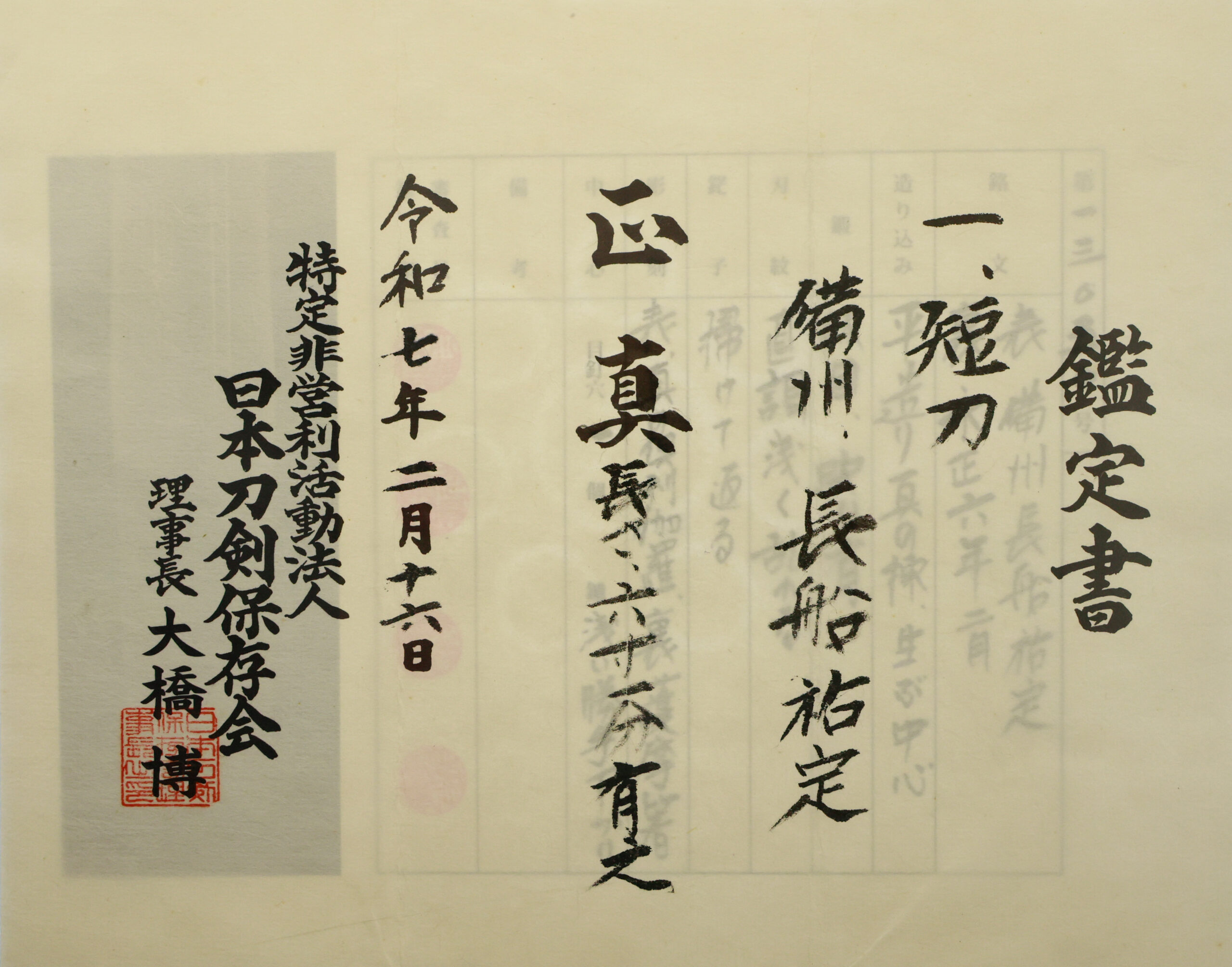
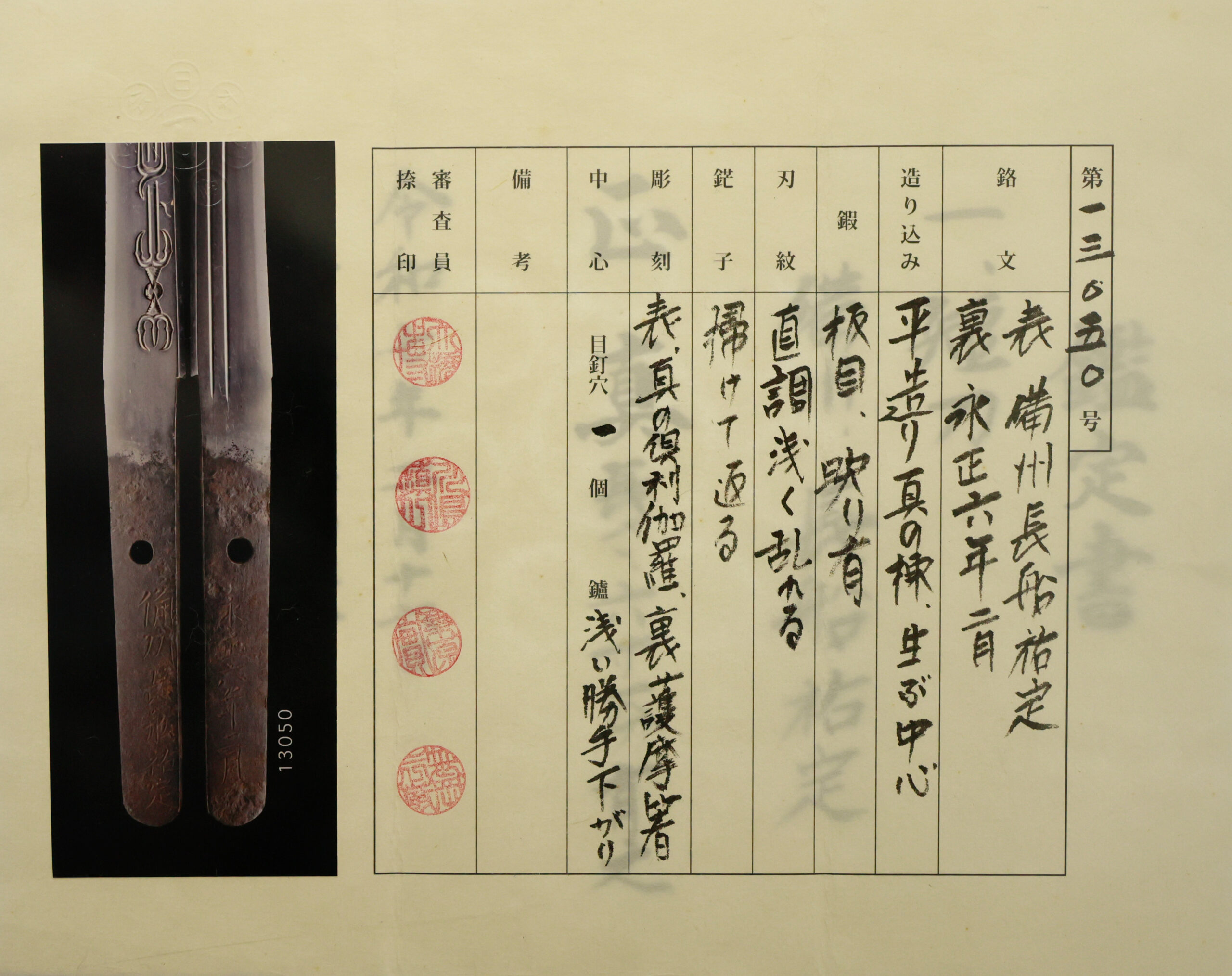
Registration Number: Hyogo 101195
The Board of Education in Hyogo prefecture issued a registration paper for this sword. It is called Jyu Hou Touken Rui Torokusho (銃砲刀剣類登録証). Bunkacho (The Agency for Cultural Affairs) acknowledges a Japanese sword with this paper as a work of art.
The sword needs to be traditionally hand-forged and made of Tamahagane carbon steel to be registered in the system. With this paper, its owner in Japan can legally own an authentic Japanese sword. Based on this registration number, we will apply for its export permit.
This paper will need to be returned to the board of education when the sword is being shipped abroad, but you can receive a copy of it. An English translation of this registration paper is available on request.
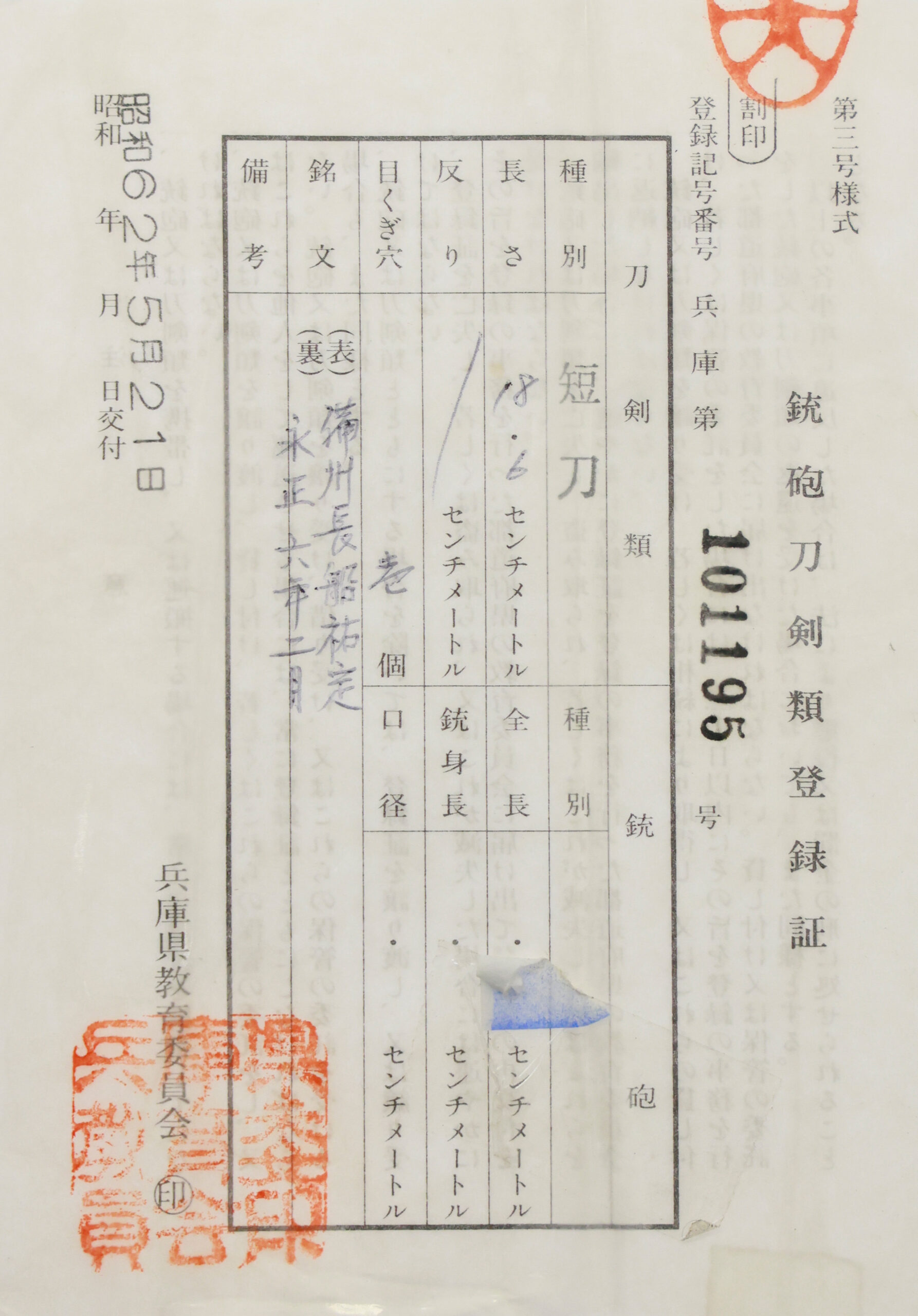
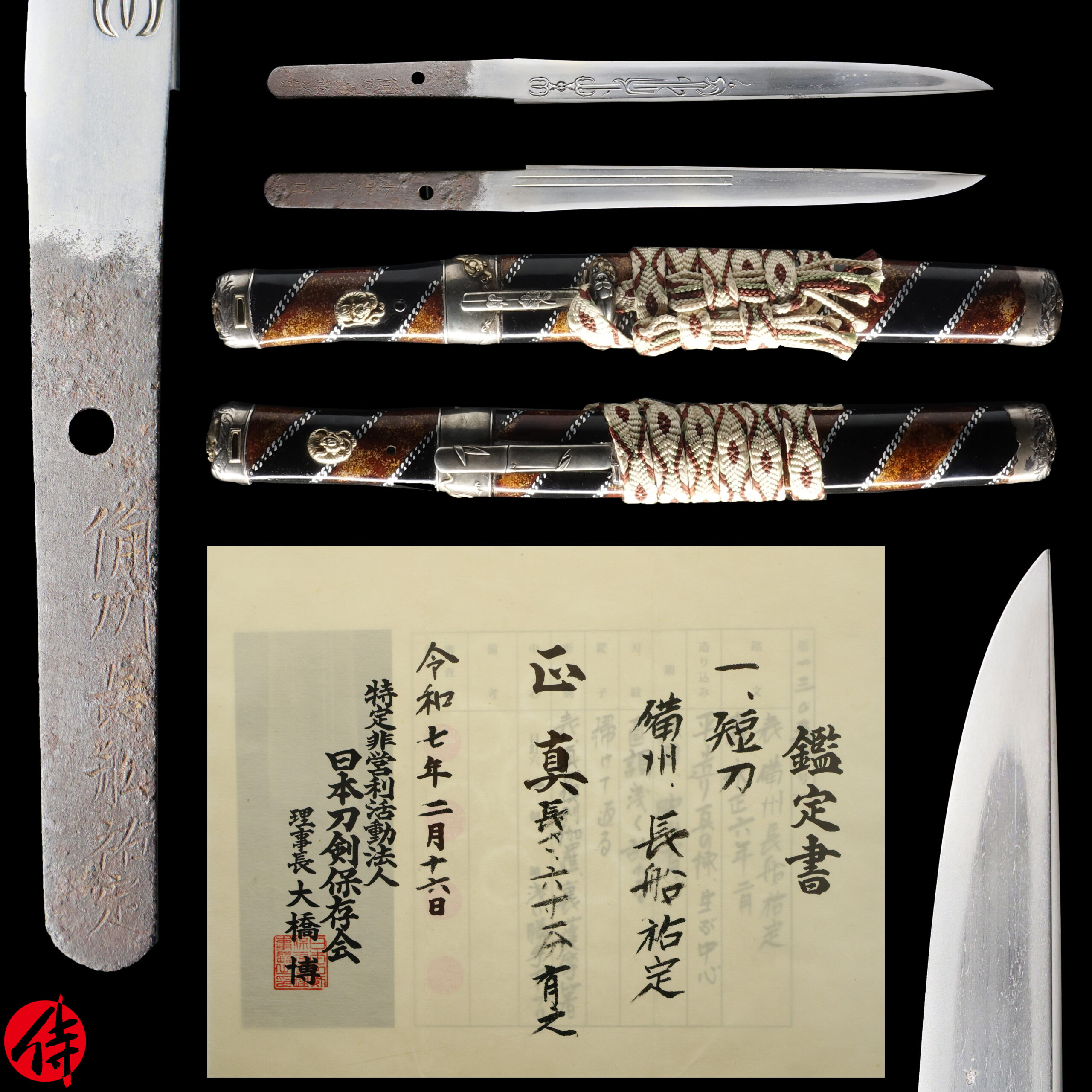
【About us】
Samurai Museum is located in Tokyo, Japan, exhibiting antique artifacts related to the Samurai history. Samurai Museum Shop is the place for those who are interested in Japanese culture and craftsmanship. We deal with antique Samurai swords/armor, traditional crafts made in Japan and so on.
【Japanese Sword& Export Process】
The Japanese swords we deal with are hand-forged edged swords made in Japan. It was made from the traditional carbon steel called TAMAHAGANE(玉鋼). Samurai Museum is familiar with the proper legal procedure for an antique/ authentic Japanese sword to be exported from Japan. We have sent more than 1000 Japanese swords for the past few years (~2025) to amazing owners who appreciate its historical value.
Each Japanese sword is registered under the Agency for Cultural Affairs and the Board of Education in Japan. They issue a registration paper for each Japanese sword for its owner in Japan to legally possess it. The Japanese sword with its registration paper means it was traditionally hand-forged in Japan.
To legally export the sword from Japan to other countries, we will have to apply for its permit to the Agency for Cultural Affairs(Bunkacho) and return the original registration paper to the Board of Education. It normally takes around 2-4 weeks to receive this permit after submitting required documents. And we would like you to expect at least 1-1.5 months for your order to arrive at your given address after you ordered. For more detailed info, please click here.
It is allowed for residents in Japan to own authentic Japanese swords without a special license as long as they come with registration papers. Please feel free to contact us if you are a resident of Japan, whether temporarily or permanently. We will also assist you when you leave Japan and need to obtain the export permit.
【Payment Method】
We accept payment through Stripe (Credit card), PayPal, Apple Pay or ChromePay, all of which are secure payment methods. Also, you don’t need to make an account on Stripe for the checkout. If you prefer other payment method, please contact us. After confirming your payment, we will apply for an export permit. You may either pay in JPY, USD, AUD, CAD,EUR CHF or GBP. The price is set in Japanese Yen. Prices in other currencies are automatically calculated based on the latest exchange rate.

* If the amount is above 1 million JPY, Stripe or wire transfer will be the only options for payment.
【Shipping】
We have shipped authentic Japanese swords to the USA, Canada, Mexico, Germany , Belgium, France, Finland, UK, Hong Kong, Australia. If you don’t live in these countries and like to order, please contact us first before making a purchase. We offer Free International Shipping as long as we can send antique Japanese swords by EMS.
We normally ship by EMS(Express Mail Service) provided by Japan Post. We will send you a tracking number for your order as soon as we hand it to the post office. We will put 100 % insurance on the shipping document without any extra charge. Based on the total amount, there might be a duty tax or other fee for you to pay, depending on the countries. We use package cushioning to protect the item and put it in a PVC pipe, which is one of the most secure packages because of its durability.
It will normally takes 5-14 days for the item to arrive at your given address after we dispatch it. Time of delivery is estimated as accurately as possible by the carrier but does not take into account any delays beyond our control such as by inclement weather, post office holiday seasons.
* If you live in Australia and like to purchase an authentic Japanese sword, please click here to know the detail.
* If you live in the UK and like to purchase an authentic Japanese sword, please contact us first and click here to know the detail.

【Review】
Here is one of the reviews we received from a customer who purchased an authentic Japanese sword from us. For more reviews, please click here.
“My experience overall with the whole process was wonderful. I had many questions about the history and process to purchase these treasures. All my questions were answered very timely and complete. The staff is very knowledgeable and very well versed if any questions do arise.”
【How to make sure the condition】
Please keep in mind that what you are going to purchase is an antique item. We uploaded high resolution photos for you to check its condition thoroughly. If you like to see more photos with different angles, please feel free to contact us. We will be happy to send them to you so that you can make informed decision. It is essential for us to know that you are happy with your choice of a sword. and we are prepared to use the best of our ability to serve you.
【How To Contact Us】
Please contact us through email, Facebook Messenger or Live Chat if you have any questions. You can find each icon on the right side of the website. Please click one of them to reach us. We will reply to you within 1-2 business days.
【The Art of Nihonto (Japanese Sword)】
Samurai’s history is a profound, eloquent legacy of ancient Japanese warriors in which millions of people worldwide are being fascinated. If you like to find out the art of Nihonto, please click here.
【A Guide to Japanese Sword Maintenance】
After acquiring an genuine Japanese sword, it is also important to know how to take good care of it. Here is the special video for you. Mr. Paul Martin, Japanese sword expert, shows you how to give proper maintenance to your sword. By mastering how to clean the Japanese sword, its aesthetic beauty will last forever.
When you purchase a Japanese sword from us, you can get a Free Japanese sword maintenance kit. It comes with four tools(Choji Oil, Uchiko Whetstone Powder, Peg remover, Oil Applicator). By watching the video instruction above , you can enjoy learning how to maintain your Japanese sword while appreciating it. If you have any difficulty assembling the sword or cleaning the blade, you can feel free to contact us.
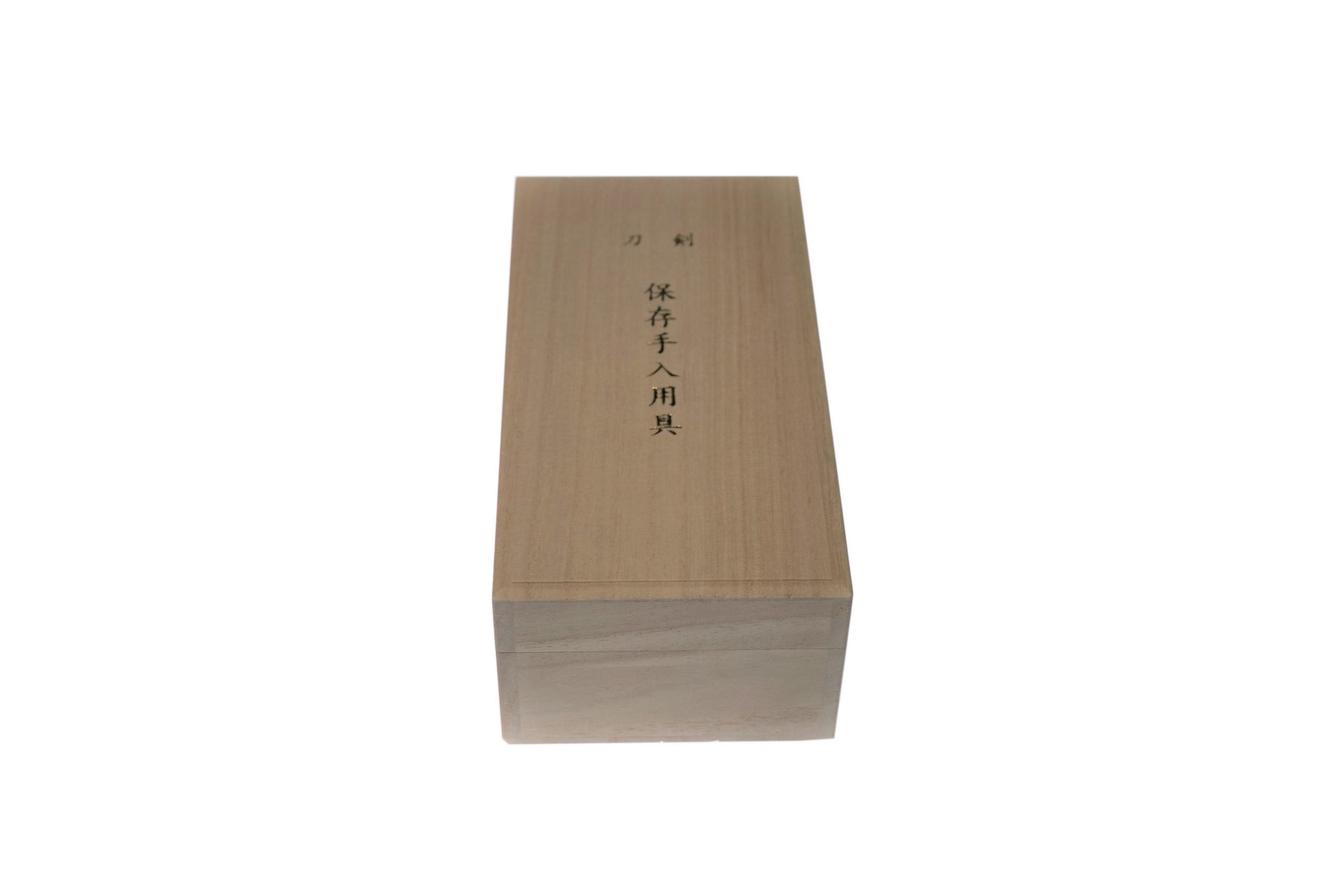
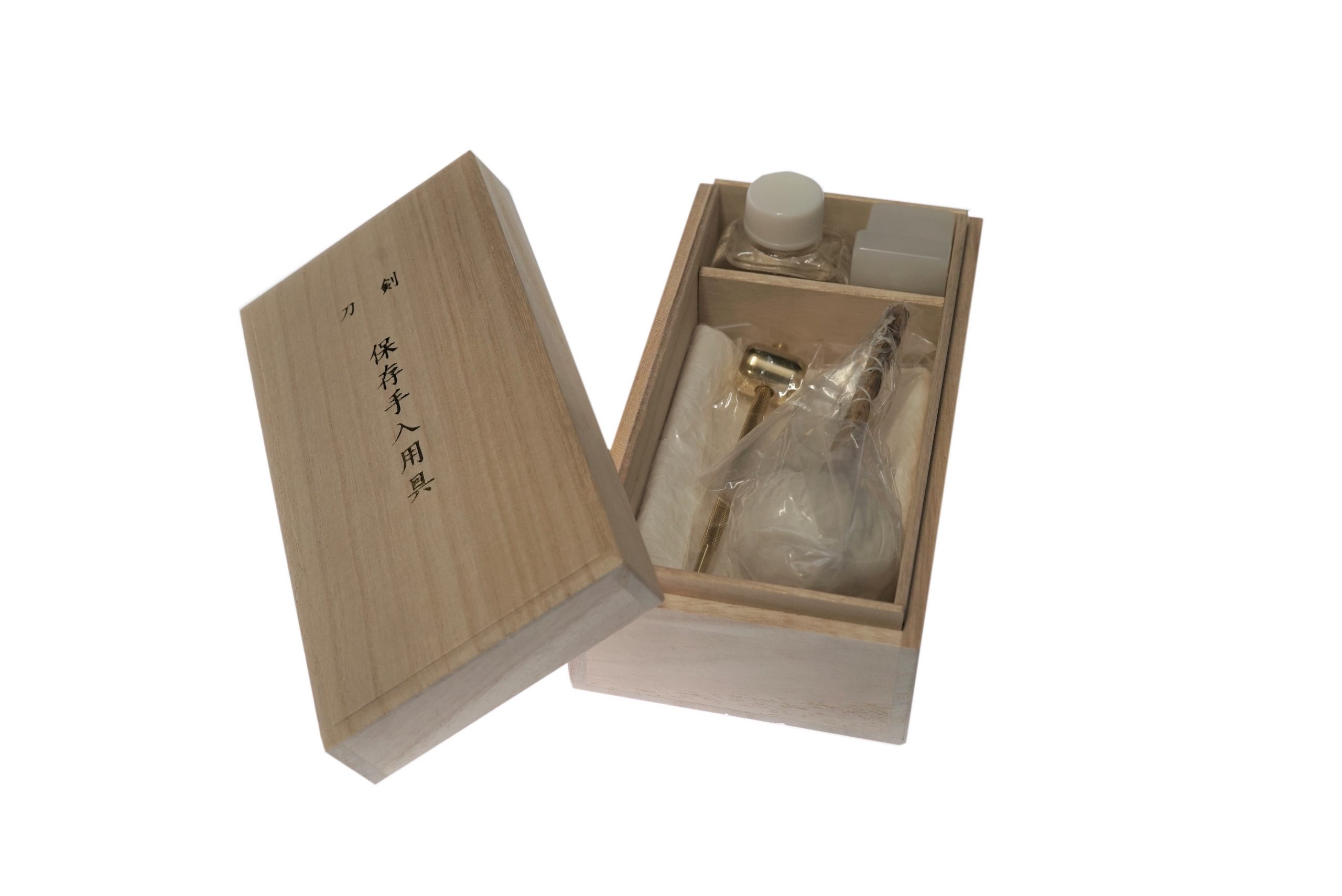
MORE ANTIQUE JAPANESE SWORD FOR SALE
SWORDS WITHOUT CERTIFICATES FOR SALE
LEARN JAPANESE SWORD TERMINOLOGY
Thank you for reading all the information on the page. If you have any difficulty choosing the right Japanese sword for you, we will be more than happy to help you find the one that speaks to you the most. Please feel free to contact us.
